

Eight Disciplines of Problem Solving (8D)
– Eight Disciplines of Problem Solving –
⇓ Introduction to 8D
⇓ What is 8D
⇓ Why Apply 8D
⇓ When to Apply 8D
⇓ How to Apply 8D

Introduction to Eight Disciplines of Problem Solving (8D)
The Eight Disciplines of Problem Solving (8D) is a problem solving methodology designed to find the root cause of a problem, devise a short-term fix and implement a long-term solution to prevent recurring problems. When it’s clear that your product is defective or isn’t satisfying your customers, an 8D is an excellent first step to improving Quality and Reliability.
Ford Motor Company developed this problem solving methodology, then known as Team Oriented Problem Solving (TOPS), in the 1980s. The early usage of 8D proved so effective that it was adopted by Ford as the primary method of documenting problem solving efforts, and the company continues to use 8D today.
8D has become very popular among manufacturers because it is effective and reasonably easy to teach. Below you’ll find the benefits of an 8D, when it is appropriate to perform and how it is performed.
What is Eight Disciplines of Problem Solving (8D)
The 8D problem solving process is a detailed, team oriented approach to solving critical problems in the production process. The goals of this method are to find the root cause of a problem, develop containment actions to protect customers and take corrective action to prevent similar problems in the future.
The strength of the 8D process lies in its structure, discipline and methodology. 8D uses a composite methodology, utilizing best practices from various existing approaches. It is a problem solving method that drives systemic change, improving an entire process in order to avoid not only the problem at hand but also other issues that may stem from a systemic failure.
8D has grown to be one of the most popular problem solving methodologies used for Manufacturing, Assembly and Services around the globe. Read on to learn about the reasons why the Eight Disciplines of Problem Solving may be a good fit for your company.
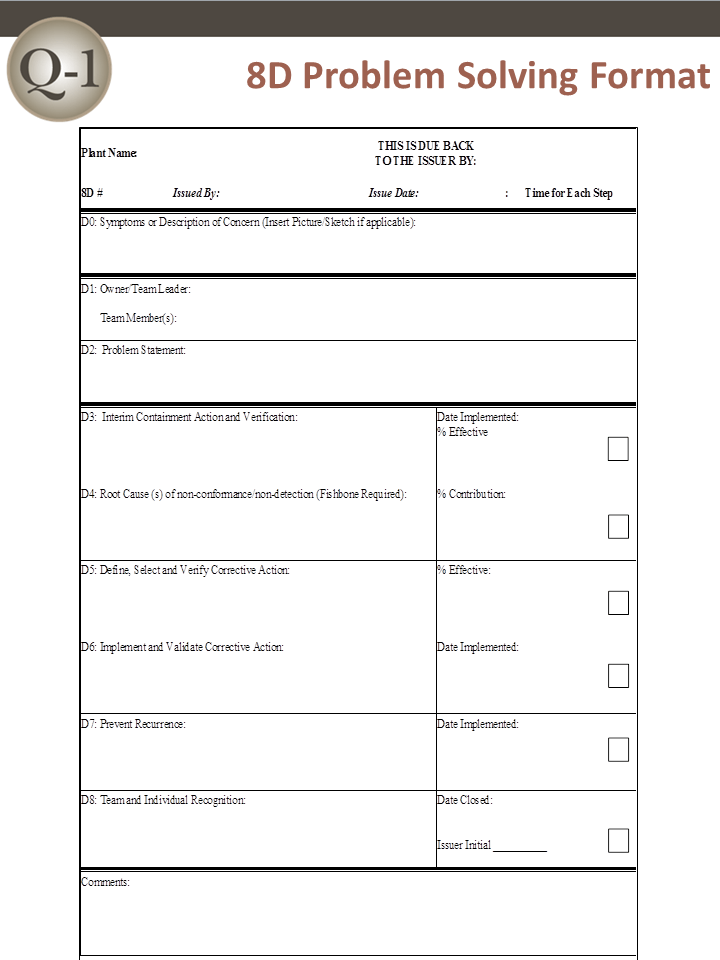
Why Apply Eight Disciplines of Problem Solving (8D)
The 8D methodology is so popular in part because it offers your engineering team a consistent, easy-to-learn and thorough approach to solving whatever problems might arise at various stages in your production process. When properly applied, you can expect the following benefits:
- Improved team oriented problem solving skills rather than reliance on the individual
- Increased familiarity with a structure for problem solving
- Creation and expansion of a database of past failures and lessons learned to prevent problems in the future
- Better understanding of how to use basic statistical tools required for problem solving
- Improved effectiveness and efficiency at problem solving
- A practical understanding of Root Cause Analysis (RCA)
- Problem solving effort may be adopted into the processes and methods of the organization
- Improved skills for implementing corrective action
- Better ability to identify necessary systemic changes and subsequent inputs for change
- More candid and open communication in problem solving discussion, increasing effectiveness
- An improvement in management’s understanding of problems and problem resolution
8D was created to represent the best practices in problem solving. When performed correctly, this methodology not only improves the Quality and Reliability of your products but also prepares your engineering team for future problems.
When to Apply Eight Disciplines of Problem Solving (8D)
The 8D problem solving process is typically required when:
- Safety or Regulatory issues has been discovered
- Customer complaints are received
- Warranty Concerns have indicated greater-than-expected failure rates
- Internal rejects, waste, scrap, poor performance or test failures are present at unacceptable levels
How to Apply Eight Disciplines of Problem Solving (8D)
The 8D process alternates inductive and deductive problem solving tools to relentlessly move forward toward a solution. The Quality-One approach uses a core team of three individuals for inductive activities with data driven tools and then a larger Subject Matter Expert (SME) group for the deductive activities through brainstorming, data-gathering and experimentation.
D0: Prepare and Plan for the 8D
Proper planning will always translate to a better start. Thus, before 8D analysis begins, it is always a good idea to ask an expert first for their impressions. After receiving feedback, the following criterion should be applied prior to forming a team:
Collect information on the symptoms
Use a Symptoms Checklist to ask the correct questions
Identify the need for an Emergency Response Action (ERA), which protects the customer from further exposure to the undesired symptoms
D1: Form a Team
A Cross Functional Team (CFT) is made up of members from many disciplines. Quality-One takes this principle one step further by having two levels of CFT:
- The Core Team Structure should involve three people on the respective subjects: product, process and data
- Additional Subject Matter Experts are brought in at various times to assist with brainstorming, data collection and analysis
Teams require proper preparation. Setting the ground rules is paramount. Implementation of disciplines like checklists, forms and techniques will ensure steady progress. 8D must always have two key members: a Leader and a Champion / Sponsor:
- The Leader is the person who knows the 8D process and can lead the team through it (although not always the most knowledgeable about the problem being studied)
- The Champion or Sponsor is the one person who can affect change by agreeing with the findings and can provide final approval on such changes
D2: Describe the Problem
The 8D method’s initial focus is to properly describe the problem utilizing the known data and placing it into specific categories for future comparisons. The “Is” data supports the facts whereas the “Is Not” data does not. As the “Is Not” data is collected, many possible reasons for failure are able to be eliminated. This approach utilizes the following tools:
- Problem Statement
- Affinity Diagram (Deductive tool)
- Fishbone/Ishikawa Diagram (Deductive tool)
- Problem Description
D3: Interim Containment Action
In the interim, before the permanent corrective action has been determined, an action to protect the customer can be taken. The Interim Containment Action (ICA) is temporary and is typically removed after the Permanent Correct Action (PCA) is taken.
- Verification of effectiveness of the ICA is always recommended to prevent any additional customer dissatisfaction calls
D4: Root Cause Analysis (RCA) and Escape Point
The root cause must be identified to take permanent action to eliminate it. The root cause definition requires that it can be turned on or off, at will. Activities in D4 include:
- Comparative Analysis listing differences and changes between “Is” and “Is Not”
- Development of Root Cause Theories based on remaining items
- Verification of the Root Cause through data collection
- Review Process Flow Diagram for location of the root cause
- Determine Escape Point, which is the closest point in the process where the root cause could have been found but was not
D5: Permanent Corrective Action (PCA)
The PCA is directed toward the root cause and removes / changes the conditions of the product or process that was responsible for the problem. Activities in D5 include:
- Establish the Acceptance Criteria which include Mandatory Requirements and Wants
- Perform a Risk Assessment / Failure Mode and Effects Analysis (FMEA) on the PCA choices
- Based on risk assessment, make a balanced choice for PCA
- Select control-point improvement for the Escape Point
- Verification of Effectiveness for both the PCA and the Escape Point are required
D6: Implement and Validate the Permanent Corrective Action
To successfully implement a permanent change, proper planning is essential. A project plan should encompass: communication, steps to complete, measurement of success and lessons learned. Activities in D6 include:
- Develop Project Plan for Implementation
- Communicate the plan to all stakeholders
- Validation of improvements using measurement
D7: Prevent Recurrence
D7 affords the opportunity to preserve and share the knowledge, preventing problems on similar products, processes, locations or families. Updating documents and procedures / work instructions are expected at this step to improve future use. Activities in D7 include:
- Review Similar Products and Processes for problem prevention
- Develop / Update Procedures and Work Instructions for Systems Prevention
- Capture Standard Work / Practice and reuse
- Assure FMEA updates have been completed
- Assure Control Plans have been updated
D8: Closure and Team Celebration
Teams require feedback to allow for satisfactory closure. Recognizing both team and individual efforts and allowing the team to see the previous and new state solidifies the value of the 8D process. Activities in D8 include:
- Archive the 8D Documents for future reference
- Document Lessons Learned on how to make problem solving better
- Before and After Comparison of issue
- Celebrate Successful Completion
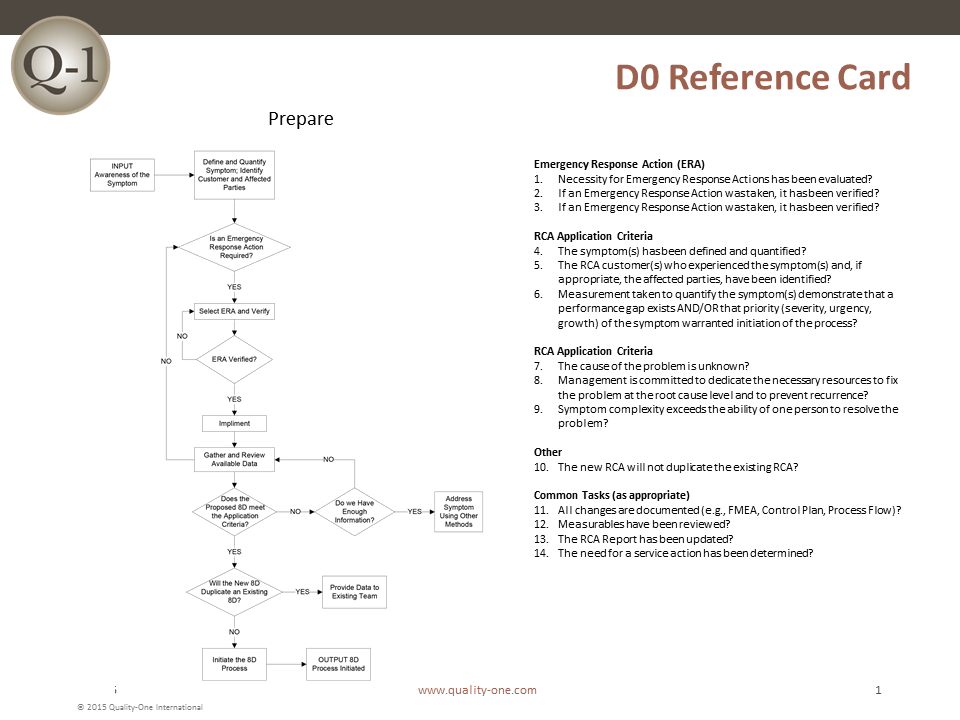
8D and Root Cause Analysis (RCA)
The 8D process has Root Cause Analysis (RCA) imbedded within it. All problem solving techniques include RCA within their structure. The steps and techniques within 8D which correspond to Root Cause Analysis are as follows:
- Problem Symptom is quantified and converted to “Object and Defect”
- Problem Symptom is converted to Problem Statement using Repeated Whys
- Possible and Potential Causes are collected using deductive tools (i.e. Fishbone or Affinity Diagram)
- Problem Statement is converted into Problem Description using Is / Is Not
- Problem Description reduces the number of items on the deductive tool (from step 3)
- Comparative Analysis between the Is and Is Not items (note changes and time)
- Root Cause theories are developed from remaining possible causes on deductive tool and coupled with changes from Is / Is Not
- Compare theories with current data and develop experiments for Root Cause Verification
- Test and confirm the Root Causes
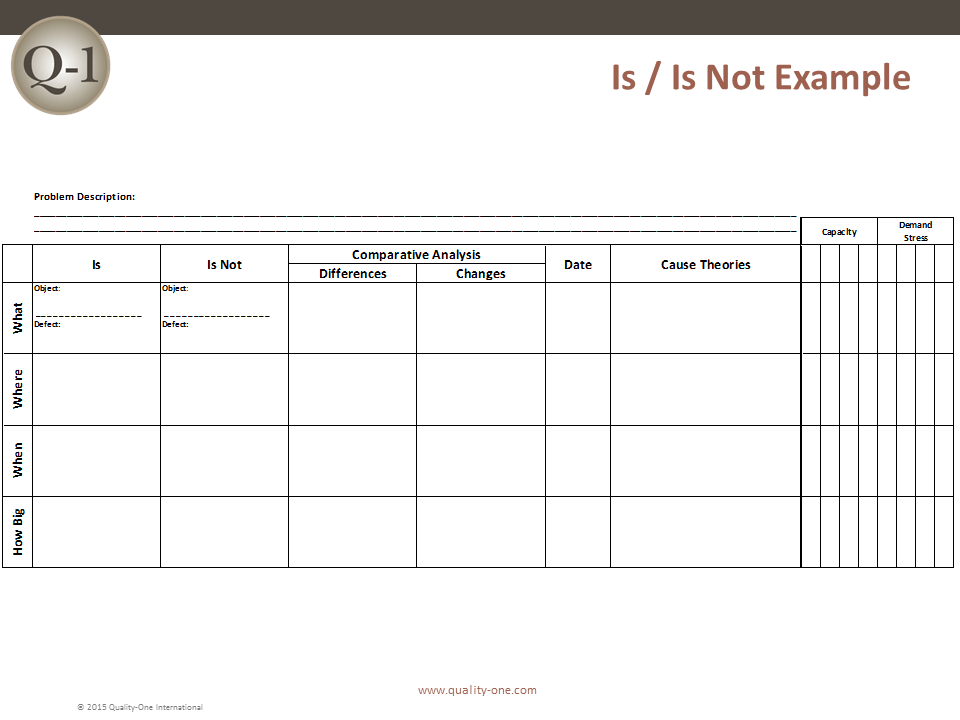
Example: Multiple Why Technique
The Multiple / Repeated Why (Similar to 5 Why) is an inductive tool, which means facts are required to proceed to a more detailed level. The steps required to determine problem statement are:
- Problem Symptom is defined as an Object and Defect i.e. “Passenger Injury”
- Why? In every case “SUV’s Roll Over”
- Why? In every case, it was preceded by a “Blown Tire”
- Why? Many explanations may be applied, therefore the team cannot continue with another repeated why past “Blown Tire”
- Therefore, the Problem Statement is “Blown Tire”
- Why? Low (Air) Pressure, Tire Defect (Degradation of an Interface) and High (Ambient) Temperature
- Counter measures assigned to low pressure and tire defect
This example uses only 4 of the 5 Whys to determine the root causes without going further into the systemic reasons that supported the failure. The Repeated Why is one way to depict this failure chain. Fault Tree Analysis (FTA) could also be used.
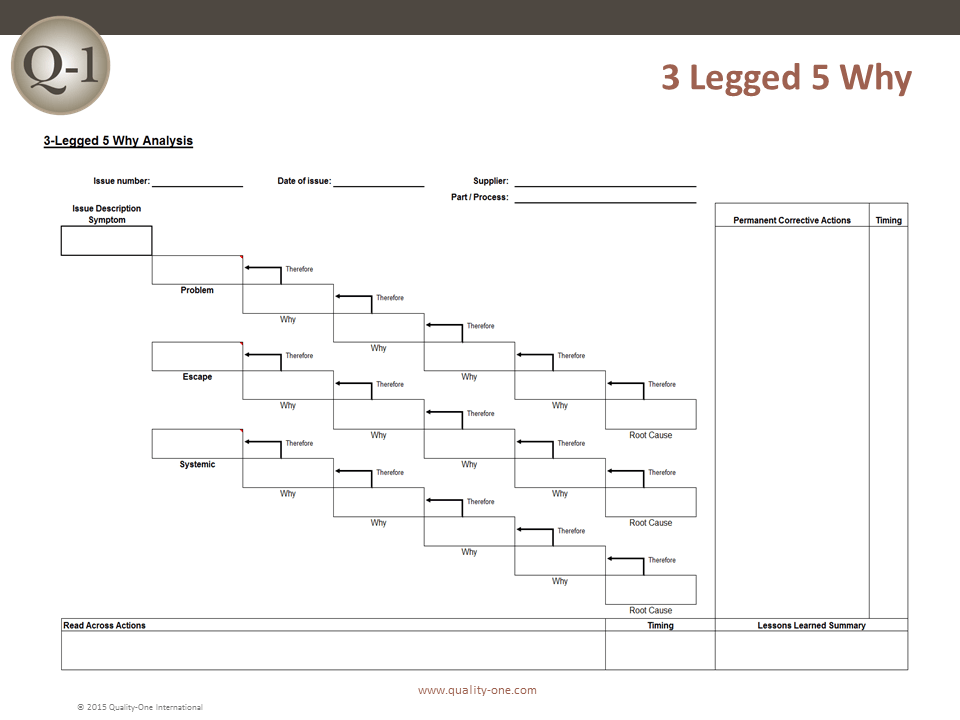
Learn More About Eight Disciplines of Problem Solving (8D)
Quality-One offers Quality and Reliability Support for Product and Process Development through Consulting, Training and Project Support. Quality-One provides Knowledge, Guidance and Direction in Quality and Reliability activities, tailored to your unique wants, needs and desires. Let us help you Discover the Value of 8D Consulting , 8D Training or 8D Project Support .
Contact Us | Discover the Value!
(248) 280-4800 | [email protected]
Remember Me
- Don't have an account? Register
- Lost your password? Click here
- Already have an account? Log in

The 8D of Root Cause Analysis: A Comprehensive Guide to Addressing Non-Conformances Effectively
- Ossian Muscad
- November 23, 2023
- No Comments

Last Updated on November 23, 2023 by Ossian Muscad
The 8D Root Cause Analysis is a robust, team-oriented problem-solving methodology initially developed by Ford in the late 1980s. It is an invaluable tool for addressing nonconformances within an organization, offering systematic steps to identify, correct, and eliminate recurring problems. This comprehensive guide is designed to provide an in-depth understanding of the method, its application, and its benefits.
Addressing nonconformances efficiently and effectively is critical in today’s fast-paced manufacturing environment. Failing to do so could lead to decreased product quality, increased production costs, and potential reputational damage. The 8D Root Cause Analysis assists in pinpointing the underlying issues, enabling organizations to implement corrective actions that mitigate risks, enhance product quality, and improve overall operational efficiency.
This guide is your roadmap to mastering the 8D Root Cause Analysis. We delve into its nuances, reveal best practices, and highlight common pitfalls to avoid. Whether you’re a novice looking to get started or a seasoned professional seeking to refine your problem-solving skills, this guide offers a comprehensive overview of using the 8D method to resolve nonconformances effectively.
Understanding 8D Root Cause Analysis
The 8D Root Cause Analysis is a step-by-step problem-solving methodology designed to find the root cause of a problem, devise a short-term fix, and implement a long-term solution to prevent recurring issues. The 8D process involves eight disciplines that promote root cause analysis and preventive action.
Ford first introduced the 8D methodology in its 1987 Team-Oriented Problem Solving manual. The idea was to create a systemic approach to problem-solving that was efficient, effective, and adaptable. The 8D tool has since evolved and is now regarded as Ford’s primary problem-solving method, Global 8D.
There are several key principles and components of the 8D process:
- Team Establishment: Assemble a team of people with product/process knowledge, allocate roles, and define the problem.
- Problem Description: Describe the problem accurately and in measurable terms.
- Immediate Containment Actions: Define and implement containment actions to isolate the problem from any customer.
- Root Cause Identification: Identify all potential causes that could explain why the problem occurred. Then, evaluate each potential cause in light of the problem description and available facts.
- Choose and Verify Corrective Actions: Confirm that the selected corrective actions will resolve the problem for the customer and will not cause undesirable side effects.
- Implement and Validate Corrective Actions: Develop and execute optimal corrective measures for effective resolution.
- Prevent Recurrence: To prevent the recurrence of this and similar issues, it is crucial to enhance the management systems, operation systems, practices, and procedures. This will ensure improved efficiency, effectiveness, and problem-solving capabilities.
- Congratulations: Recognize the collective efforts of the team. The organization must extend a formal expression of gratitude to the team for their invaluable contributions.
The Eight Disciplines Explained
The Eight Disciplines of the 8D Root Cause Analysis act as a comprehensive roadmap to navigate problem-solving in a structured and systematic manner. Each discipline is designed to address a specific part of the process, starting from team formation, problem identification, and immediate action and culminating in the full implementation of long-term corrective measures.
This section delves into each of these disciplines, providing a detailed understanding of their function, implementation, and significance in the overall 8D methodology:
D1: Form a Team
The first discipline of the 8D Root Cause Analysis underscores the importance of assembling a competent team. A well-rounded team with diverse skills and comprehensive product/process knowledge is the backbone of successful problem-solving. Team formation should not be taken lightly, as the team’s collective expertise will be the driving force behind identifying the root cause and formulating effective corrective measures.
Roles and responsibilities should be distinctly defined for each team member to ensure smooth collaboration and efficient task management. Each member’s role should align with their expertise, enabling them to contribute effectively to the problem-solving process.
Responsibilities might include leading the team, facilitating communication, managing resources, performing data analysis, or developing corrective measures. By clearly defining roles and responsibilities, organizations can streamline problem-solving, mitigate conflicts, and ensure productive collaboration.
D2: Define the Problem
The second discipline, “Define the Problem,” is a critical step that directs the entire problem-solving process. Firmly rooted in evidence and data, it thoroughly examines the nonconformance to create a clear, concise, and measurable problem statement.
This discipline emphasizes the importance of distinguishing between symptoms and the actual problem. Techniques such as the ‘5 Whys’ and ‘Is/Is Not’ analysis can be used to clarify the problem’s nature and scope.
For instance, consider a scenario in a manufacturing company where a noticeable increase in product defects has been observed. A simple problem statement might be, “Product defect rates have increased by 20% over the last three months.”
However, the team might discover that the issue is more specific through rigorous problem definition techniques like the ‘5 Whys’—”Machine XYZ’s calibration settings are off by 0.05 units, causing a 20% increase in product defects over the last three months.”
Defining the problem accurately is crucial as it paves the way for subsequent steps in the 8D Root Cause Analysis process. It enables teams to focus on addressing the actual problem and not just the symptoms, thereby increasing the effectiveness of the corrective actions implemented.
D3: Containment Actions
The third discipline, “Containment Actions,” centers on implementing quick, temporary solutions to prevent further problem escalation. During this stage, the team should prioritize immediate actions that can effectively isolate the issue, preventing it from affecting customers or other parts of the production process.
While these actions are not meant to address the root cause of the problem, they serve as vital stopgap measures, minimizing negative impacts. At the same time, the team works on identifying the root cause and devising long-term corrective measures. This stage emphasizes the need for swift action, as delays can worsen the problem or branch out into other areas.
Temporary containment actions could include rerouting production, increasing quality checks, or informing customers about potential delays. By swiftly implementing containment actions, teams can minimize the issue’s impact on the overall operation and customer satisfaction until a permanent solution is put in place.
D4: Root Cause Analysis
The fourth discipline, “Root Cause Analysis,” is arguably the heart of the 8D methodology. This stage involves uncovering the problem’s underlying cause, moving beyond the symptoms to identify what is truly driving the issue. A thorough root cause analysis lays the foundation for effective corrective actions that address the problem at its source. Several techniques can be employed to identify root causes accurately:
- 5 Whys: A simple yet powerful tool, the 5 Whys technique involves asking ‘why?’ repeatedly (usually five times) until the root cause is identified. Every answer serves as the foundation for the subsequent question.
- Fishbone Diagram: Also known as Ishikawa or cause-and-effect diagrams, these help teams brainstorm and categorize root causes. The ‘head’ of the fish represents the problem, and the ‘bones’ are potential root causes.
- Fault Tree Analysis: This is a top-down, deductive failure analysis in which an undesired state of a system is analyzed using Boolean logic to combine a series of lower-level events.
- Pareto Analysis: Named after economist Vilfredo Pareto, this method uses the principle that 80% of problems come from 20% of causes. It helps prioritize the potential root causes.
It’s essential to be aware of common pitfalls that can compromise the effectiveness of root cause analysis. This includes:
- Rushing the process: It’s crucial to take the time to identify the root cause accurately and not jump to conclusions too quickly.
- Overlooking systemic issues: Often, problems are not isolated incidents but symptoms of larger, systemic issues. Failing to identify these can lead to recurring problems.
- Lack of team involvement: All team members should actively participate in the root cause analysis to ensure diverse perspectives and insights.
- Focus on blame: The goal is to find the problem’s cause, not assign blame. A blame-oriented approach can stifle open discussion and prevent identifying the true root cause.
The Root Cause Analysis phase of the 8D methodology is vital in preventing the recurrence of the same or similar issues. It demands a systematic approach, active team involvement, and a focus on factual evidence over assumptions. Steering clear of common pitfalls and using proven techniques can greatly enhance the effectiveness and efficiency of this process.
D5: Permanent Corrective Actions
After identifying the root cause of the problem in the previous step, the fifth discipline, “Permanent Corrective Actions,” revolves around developing and implementing long-term solutions that effectively address the identified root cause.
The goal is to enact changes that will prevent the recurrence of the problem in the future, going beyond temporary fixes to create sustainable improvements. To achieve this, teams should follow a strategic approach to implementing permanent corrective actions:
- Develop an Action Plan: Begin by outlining a detailed plan that includes the steps to be taken, the resources needed, and a timeline for implementation. This ensures everyone involved understands their roles and responsibilities.
- Test the Solution: Before full implementation, test the proposed solution under controlled conditions to evaluate its effectiveness. This helps identify potential issues and make necessary adjustments.
- Implement the Solution: Once the solution has proven effective, it’s time to implement it fully. This should be done in accordance with the action plan, with careful monitoring to ensure proper execution.
- Document Everything: Keep detailed records of the actions taken, their effects, and any challenges encountered. This aids in future problem-solving efforts and ensures accountability.
The final part of this stage is “Monitoring Progress,” which is crucial for assessing the effectiveness of the corrective actions over time. Regular monitoring allows teams to determine whether the actions have successfully resolved the problem and to evaluate their impact on overall operations.
If the problem persists or new issues arise, the team may need to revise their approach and consider alternative solutions. This stage reinforces the principle of continuous improvement at the heart of the 8D methodology, encouraging teams to constantly review and refine their practices in pursuit of operational excellence.
D6: Preventive Measures
The sixth discipline, “Preventive Measures,” underscores the proactive approach of the 8D methodology, focusing on taking steps to prevent the recurrence of similar issues in the future. It’s not enough to correct a problem; teams should also implement preventive measures to ensure the same or similar issues do not occur again.
This proactive approach can save time and resources and enhance overall operational efficiency. The following key steps should be taken to establish effective preventative measures:
- System Walk-throughs and Audits: Periodically review processes and systems to identify potential areas of concern before they become a problem.
- FMEA (Failure Mode and Effect Analysis): This is a step-by-step approach for identifying all possible failures in a design, a manufacturing or assembly process, or a product or service.
- Preventive Maintenance: Regular maintenance can catch and address issues before they develop into larger problems.
- Staff Training and Development: Ensure all team members are adequately trained in procedures, protocols, and problem-solving methods.
- Update Documentation: Update procedures and protocols based on lessons learned from the problem-solving process, ensuring they reflect any changes made.
The importance of preventive measures is well illustrated in various industry case studies. For instance, a renowned automobile manufacturer used the 8D methodology to identify a recurring problem in their assembly line, causing significant production delays.
Through a thorough root cause analysis, the team identified the problem and successfully implemented permanent corrective actions. However, the preventive measures, including regular system audits and staff training, ensured the issue did not recur, saving the company significant time and resources in the future.
Another example is a pharmaceutical company that faced a quality assurance issue. The company rectified the problem and took preventive measures, such as updating their documentation and procedures, conducting regular preventive maintenance, and carrying out systematic FMEA.
These steps helped them maintain the high-quality standards of their products and significantly reduce the risk of similar issues in the future.
D7: Verification of Effectiveness
The seventh discipline of the 8D methodology, “Verification of Effectiveness,” confirms the success of the implemented corrective actions. It provides the opportunity to reflect on the changes made and assess their impact on the problem faced. This discipline reinforces the importance of implementing solutions and validating their effectiveness in resolving the problem and improving operations.
This systematic evaluation involves determining whether the corrective actions have met the set objectives, solved the problem, and prevented its recurrence. If the corrective actions have been effective, they should result in noticeable improvements in the processes impacted and overall operations.
It’s essential to remember that verification of effectiveness isn’t an immediate step—it often necessitates a waiting period post-implementation to monitor changes and accurately assess impact. To objectively measure the effectiveness of the corrective actions, it’s crucial to rely on metrics and KPIs. These could include:
- Problem Recurrence Rate: A decrease in the recurrence of the same or similar problems is a strong indicator of effective corrective actions.
- Process Performance Metrics: These include metrics related to quality, efficiency, or productivity, depending on the specific problem addressed.
- Overall Operational Performance: Broader operational metrics like customer satisfaction, cost savings, or reduced waste can also indicate the effectiveness of the corrective actions.
- Employee Feedback: While not a quantitative metric, feedback from team members involved in the process can provide valuable insights into the effectiveness of the changes.
Remember, the chosen metrics and KPIs should be clearly defined, measurable, and directly related to the problem at hand and the objectives of the corrective actions. Regular monitoring and reviewing of these indicators will contribute to a more objective and accurate evaluation of the effectiveness of the implemented corrective actions.
D8: Documentation and Closure
The eighth and final discipline highlights the importance of thoroughly documenting the 8D process and its outcomes. Detailed documentation of the problem, the investigation process, the root cause analysis, the implemented corrective actions, and their effectiveness provides valuable insights for future reference. It aids in knowledge transfer within the organization and can be used as a reference to tackle similar problems in the future, enhancing problem-solving efficiency.
Finalizing the 8D process involves:
- Reviewing the entire process.
- Validating the implemented corrective actions.
- Formally recognizing the efforts of everyone involved in the problem-solving process.
This step underscores the importance of team recognition and closure, reinforcing a sense of achievement and encouraging continued commitment to operational excellence. After all, the goal of the 8D methodology is not just to solve individual problems but to foster an environment of continuous learning and improvement.
Documenting the 8D process and achieving closure is not just an administrative task; it’s an integral part of the problem-solving process. It ensures that the lessons learned and best practices adopted remain confined to one problem and institutionalized within the organization, contributing to its long-term success and resilience.
Benefits of Implementing 8D Root Cause Analysis
Implementing the 8D root cause analysis in an organization brings along numerous advantages. These benefits range from enhanced product quality and customer satisfaction to cost savings and efficiency, and they ultimately contribute to fostering a culture of continuous improvement. Let’s delve deeper into these benefits.
Improved Quality and Customer Satisfaction
When organizations use the 8D root cause analysis, they invest in a systematic approach that addresses the root causes of problems rather than just their symptoms. This results in improved product or service quality, as issues are temporarily fixed and eliminated from the process.
Consequently, improvement in quality leads to increased customer satisfaction. Customers are likely to remain loyal to a brand that consistently meets or exceeds their expectations, enhancing the organization’s reputation and market share.
Cost Reduction and Efficiency
The 8D root cause analysis is also instrumental in reducing costs and enhancing efficiency. Addressing problems at their root cause extends beyond immediate cost savings from problem resolution. It also prevents the recurrence of the problem, which could lead to additional costs in the future. Moreover, by streamlining processes and eliminating nonconformances, organizations can significantly improve their efficiency, using their resources better and optimizing productivity.
Building a Culture of Continuous Improvement
One of the most profound advantages of the 8D methodology is its contribution to cultivating a culture of continuous improvement within an organization. The 8D root cause analysis emphasizes learning from mistakes, making necessary changes, and consistently looking for ways to improve.
This approach encourages team members to take ownership of problems, collaborate on solutions, and continually strive to enhance their performance. It fosters a proactive rather than reactive mindset, driving ongoing improvement and innovation.
Challenges and Best Practices
Implementing the 8D root cause analysis in an organization can pose some challenges, particularly for those new to the process. Recognizing potential obstacles in advance can help teams prepare and navigate these hurdles more effectively. Some common challenges include:
- Lack of Training: Without proper training and understanding of the 8D methodology, teams might find it difficult to apply the method correctly.
- Inadequate Resources: Undertaking a thorough root cause analysis and implementing corrective actions often require time, money, and manpower, which can be lacking in some organizations.
- Resistance to Change: Like any new process, the 8D method can meet resistance from team members who are comfortable with existing processes and cautious of change.
- Insufficient Data Collection and Analysis: Gathering and analyzing data is critical to identifying the root cause and evaluating the success of corrective actions but is often overlooked or inadequately done.
- Failure to Follow Through: The final steps of the 8D process—verification of effectiveness and documentation—can sometimes be neglected, undermining the success and sustainability of the corrective actions.
Best Practices for a Successful 8D Process
Organizations should adhere to certain best practices to successfully implement the 8D root cause analysis. These include:
- Training and Education: Provide team members with comprehensive training on the 8D methodology to ensure they understand how to effectively apply it.
- Resource Allocation: Dedicate the necessary resources—time, budget, and personnel—to ensure a thorough and effective problem-solving process.
- Open Communication: Foster a culture of open communication, encouraging team members to voice concerns, share ideas, and collaborate on solutions.
- Data-Driven Decision Making: The 8D process should be guided by accurate and comprehensive data. Invest in data collection and analysis tools and make decisions based on clear, relevant metrics.
- Commitment to Follow-through: It’s crucial to fully commit to each step of the process, especially the often-neglected final steps of verification and documentation. This ensures the sustainability of corrective actions and provides a reference for future problem-solving activities.
Tools and Software for 8D Root Cause Analysis
There are a myriad of tools and software available that can facilitate the 8D root cause analysis process. These tools have been designed to streamline the process, improve accuracy, and increase efficiency, making it easier for teams to identify nonconformities, determine their root cause, and implement effective corrective actions.
Overview of Available Tools
Some of the tools available for 8D root cause analysis stand out due to their comprehensive features and user-friendly interfaces. The options below provide an overview of some of the top tools and software to consider:
- Problem-Solving Software: These are comprehensive programs designed to guide teams through the entire 8D process, from problem identification to resolution and documentation.
- Data Analysis Tools: These tools allow teams to collect, organize, analyze, and visualize data, aiding in identifying root causes.
- Project Management Tools: These platforms help track the progress of corrective actions, assign tasks, and ensure accountability.
- Low-Code Platforms: Low-code platforms provide the means to build custom applications for root cause analysis, allowing organizations to tailor their tools to their specific needs. These platforms are user-friendly and require minimal coding knowledge, making them accessible to all team members.
- Collaboration Tools: Collaboration tools facilitate teamwork and communication, making it easier for team members to work together on a problem-solving project.
Choosing the Right Software for Your Organization
Selecting the right software for 8D root cause analysis is critical to ensure effectiveness and efficiency. Here are some important tips to guide your selection process:
- Understand Your Needs: Consider the unique needs of your organization and the specific problems you’re trying to solve.
- Evaluate Features: Look for software with features that align with your needs. This may include data analysis capabilities, collaboration features, documentation tools, etc.
- Consider User-Friendliness: The software should be intuitive and easy to use. It will be difficult for your team to adopt if it’s overly complicated.
- Check Compatibility: The software should easily integrate with your existing systems.
- Assess Support and Training: Good software providers offer robust support and training to help users make the most of their tools.
- Consider Cost: While cost should not be the only factor, finding a solution that fits within your budget without compromising on essential features is important.
By carefully evaluating available tools and making an informed choice, organizations can ensure they have the right resources to effectively carry out 8D root cause analysis.
Frequently Asked Questions (FAQs)
Q1: what is the significance of the ‘d’ in the 8d method.
The ‘D’ in the 8D Method stands for ‘Disciplines,’ referring to the eight disciplined steps that the method involves. This systematic approach helps to ensure that no aspect of the problem-solving process is overlooked, improving the likelihood of finding a genuine root cause and effective corrective actions.
Q2: Is the 8D Root Cause Analysis Method applicable to all industries?
Yes, the 8D method is applicable across a wide range of industries. While initially developed within the automotive industry, systematic problem investigation, root cause identification, and corrective action implementation principles are universally relevant. However, the specific application of the method may vary depending on industry regulations, standards, and specific operational contexts.
Q3: What role does the team play in the 8D Root Cause Analysis Method?
The role of a diverse and cross-functional team is vital in the 8D method. Such a team offers a broader perspective, enabling a more extensive understanding of the problem and potential solutions. The collaborative nature of the method allows for a more thorough analysis of the problem, fosters creativity in finding solutions, and ensures shared ownership and accountability in implementing and sustaining corrective actions.
Streamline 8D Root Cause Analysis with DATAMYTE
DATAMYTE is a quality management platform with low-code capabilities. Our Digital Clipboard , in particular, is a low-code workflow automation software that features a workflow, checklist, and smart form builder. This tool lets you create custom applications for 8D root cause analysis, making capturing data, identifying nonconformities, and implementing effective corrective actions easier.
DATAMYTE also lets you conduct layered process audits, a high-frequency evaluation of critical process steps, focusing on areas with the highest failure risk or non-compliance. Conducting LPA with DATAMYTE lets you effectively identify and correct potential defects before they become major quality issues.
With DATAMYTE , you have an all-in-one solution for your 8D root cause analysis, helping you streamline and improve your problem-solving process. Book a demo now to learn more.
The 8D root cause analysis continues to be a reliable and effective method for identifying, resolving, and preventing nonconformities. It leverages a disciplined, team-oriented approach to problem-solving, ensuring a thorough investigation, accurate identification of root causes, and the implementation of effective corrective actions.
Choosing the right software tools can significantly enhance the effectiveness of your 8D process, improving your ability to analyze data, manage projects, and collaborate with your team. As we move forward, the future of root cause analysis lies in integrating advanced technologies such as artificial intelligence (AI) and machine learning.
These technologies promise to enhance the data analysis capabilities of root cause analysis tools, enabling more precise identification of root causes and prediction of potential nonconformities. Implementing the 8D method can elevate your organization’s problem-solving capabilities, reduce risk, and improve overall productivity.
Don’t hesitate to adopt this proven approach and harness the power of technology to streamline and enhance your 8D process. Invest in your future by investing in the right tools and methodologies today.
Related Articles:
- Decoding BIQS: Essential Insights for Auto Suppliers on GM’s Latest Benchmarking Tool
- A Comprehensive Guide to Torque Testing and its Methodologies

- Implementation
- Case-Studies
- White Papers
- Knowledge Base
Experts in the Connected Factory

- 1-800-455-4359
- (763) 553-0455 ext. 1
- [email protected]

How it works
For Business
Join Mind Tools
Article • 8 min read
8D Problem Solving Process
Solving major problems in a disciplined way.
By the Mind Tools Content Team
(Also known as Global 8D Problem Solving)

When your company runs into a major problem, you need to address it quickly. However, you also need to deal with it thoroughly and ensure that it doesn't recur – and this can take a lot of effort and elapsed time.
The 8D Problem Solving Process helps you do both of these seemingly-contradictory things, in a professional and controlled way. In this article, we'll look at the 8D Problem Solving Process, and we'll discuss how you can use it to help your team solve major problems.
Origins of the Tool
The Ford Motor Company® developed the 8D (8 Disciplines) Problem Solving Process, and published it in their 1987 manual, "Team Oriented Problem Solving (TOPS)." In the mid-90s, Ford added an additional discipline, D0: Plan. The process is now Ford's global standard, and is called Global 8D.
Ford created the 8D Process to help teams deal with quality control and safety issues; develop customized, permanent solutions to problems; and prevent problems from recurring. Although the 8D Process was initially applied in the manufacturing, engineering, and aerospace industries, it's useful and relevant in any industry.
The eight disciplines are shown in figure 1, below:
Figure 1: The 8D Problem Solving Process

The 8D Process works best in teams tasked with solving a complex problem with identifiable symptoms. However, you can also use this process on an individual level, as well.
Applying the Tool
To use the 8D Process, address each of the disciplines listed below, in order. Take care not to skip steps, even when time is limited; the process is only effective when you follow every step.
Discipline 0: Plan
Before you begin to assemble a team to address the problem, you need to plan your approach. This means thinking about who will be on the team, what your time frame is, and what resources you'll need to address the problem at hand.
Discipline 1: Build the Team
You should aim to put together a team that has the skills needed to solve the problem, and that has the time and energy to commit to the problem solving process.
Keep in mind that a diverse team is more likely to find a creative solution than a team of people with the same outlook (although if outlooks are too diverse, people can spend so much time disagreeing that nothing gets done).
Create a team charter that outlines the team's goal and identifies each person's role. Then, do what you can to build trust and get everyone involved in the process that's about to happen.
If your team is made up of professionals who haven't worked together before, consider beginning with team-building activities to ensure that everyone is comfortable working with one another.
Discipline 2: Describe the Problem
Once your team has settled in, describe the problem in detail. Specify the who, what, when, where, why, how, and how many; and use techniques like CATWOE and the Problem-Definition Process to ensure that you're focusing on the right problem.
Start by doing a Risk Analysis – if the problem is causing serious risks, for example, to people's health or life, then you need to take appropriate action. (This may include stopping people using a product or process until the problem is resolved.)
If the problem is with a process, use a Flow Chart , Swim Lane Diagram , or Storyboard to map each step out; these tools will help your team members understand how the process works, and, later on, think about how they can best fix it.
Discovering the root cause of the problem comes later in the process, so don't spend time on this here. Right now, your goal is to look at what's going wrong and to make sure that your team understands the full extent of the problem.
Discipline 3: Implement a Temporary Fix
Once your team understands the problem, come up with a temporary fix. This is particularly important if the problem is affecting customers, reducing product quality, or slowing down work processes.
Harness the knowledge of everyone on the team. To ensure that each person's ideas are heard, consider using brainstorming techniques such as Round Robin Brainstorming or Crawford's Slip Writing Method , alongside more traditional team problem solving discussions.
Once the group has identified possible temporary fixes, address issues such as cost, implementation time, and relevancy. The short-term solution should be quick, easy to implement, and worth the effort.
Discipline 4: Identify and Eliminate the Root Cause
Once your temporary fix is in place, it's time to discover the root cause of the problem.
Conduct a Cause and Effect Analysis to identify the likely causes of the problem. This tool is useful because it helps you uncover many possible causes, and it can highlight other problems that you might not have been aware of. Next, apply Root Cause Analysis to find the root causes of the problems you've identified.
Once you identify the source of the problem, develop several permanent solutions to it.
If your team members are having trouble coming up with viable permanent solutions, use the Straw Man Concept to generate prototype solutions that you can then discuss, tear apart, and rebuild into stronger solutions.
Discipline 5: Verify the Solution
Once your team agrees on a permanent solution, make sure that you test it thoroughly before you fully implement it, in the next step.
- Conducting a Failure Mode and Effects Analysis (FMEA) to spot any potential problems.
- Using Impact Analysis to make sure that there will be no unexpected future consequences.
- Using Six Thinking Hats to examine the fix from several different emotional perspectives.
Last, conduct a Blind Spot Analysis to confirm that you and your team haven't overlooked a key factor, or made an incorrect assumption about this solution.
Discipline 6: Implement a Permanent Solution
Once your team reaches a consensus on the solution, roll your fix out. Monitor this new solution closely for an appropriate period of time to make sure that it's working correctly, and ensure that there are no unexpected side effects.
Discipline 7: Prevent the Problem From Recurring
When you're sure that the permanent solution has solved the problem, gather your team together again to identify how you'll prevent the problem from recurring in the future.
You might need to update your organization's standards, policies, procedures, or training manual to reflect the new fix. You'll likely also need to train others on the new process or standard. Finally, you'll need to consider whether to change your management practices or procedures to prevent a recurrence.
Discipline 8: Celebrate Team Success
The last step in the process is to celebrate and reward your team's success . Say "thank you" to everyone involved, and be specific about how each person's hard work has made a difference. If appropriate, plan a party or celebration to communicate your appreciation.
Before the team disbands, conduct a Post-Implementation Review to analyze whether your solution is working as you thought, and to improve the way that you solve problems in the future.
In the late 1980s, Ford Motor Company developed the 8D (8 Disciplines) Problem Solving Process to help manufacturing and engineering teams diagnose, treat, and eliminate quality problems. However, teams in any industry can use this problem solving process.
The eight disciplines are:
- Build the Team.
- Describe the Problem.
- Implement a Temporary Fix.
- Identify and Eliminate the Root Cause.
- Verify the Solution.
- Implement a Permanent Solution.
- Prevent the Problem From Recurring.
- Celebrate Team Success.
The 8D Problem Solving Process is best used with a team solving complex problems; however, individuals can also use it to solve problems on their own.
Ford is a registered trademark of the Ford Motor Company: https://www.ford.com/
You've accessed 1 of your 2 free resources.
Get unlimited access
Discover more content
How to Guides
How to Improve Team Performance
Some Straightforward, Practical Advice on How You Can Maximise Team Performance
How to Get the Feedback You Need
Asking for the feedback you need to reflect, grow and learn
Add comment
Comments (0)
Be the first to comment!

Get 30% off your first year of Mind Tools
Great teams begin with empowered leaders. Our tools and resources offer the support to let you flourish into leadership. Join today!
Sign-up to our newsletter
Subscribing to the Mind Tools newsletter will keep you up-to-date with our latest updates and newest resources.
Subscribe now
Business Skills
Personal Development
Leadership and Management
Member Extras
Most Popular
Latest Updates

Tips for Dealing with Customers Effectively

Pain Points Podcast - Procrastination
Mind Tools Store
About Mind Tools Content
Discover something new today
Pain points podcast - starting a new job.
How to Hit the Ground Running!
Ten Dos and Don'ts of Career Conversations
How to talk to team members about their career aspirations.
How Emotionally Intelligent Are You?
Boosting Your People Skills
Self-Assessment
What's Your Leadership Style?
Learn About the Strengths and Weaknesses of the Way You Like to Lead
Recommended for you
Take care of your financial stress and wellbeing.
Improve Your Wellbeing By Taking Control of Your Finances
Business Operations and Process Management
Strategy Tools
Customer Service
Business Ethics and Values
Handling Information and Data
Project Management
Knowledge Management
Self-Development and Goal Setting
Time Management
Presentation Skills
Learning Skills
Career Skills
Communication Skills
Negotiation, Persuasion and Influence
Working With Others
Difficult Conversations
Creativity Tools
Self-Management
Work-Life Balance
Stress Management and Wellbeing
Coaching and Mentoring
Change Management
Team Management
Managing Conflict
Delegation and Empowerment
Performance Management
Leadership Skills
Developing Your Team
Talent Management
Problem Solving
Decision Making
Member Podcast
.css-s5s6ko{margin-right:42px;color:#F5F4F3;}@media (max-width: 1120px){.css-s5s6ko{margin-right:12px;}} AI that works. Coming June 5, Asana redefines work management—again. .css-1ixh9fn{display:inline-block;}@media (max-width: 480px){.css-1ixh9fn{display:block;margin-top:12px;}} .css-1uaoevr-heading-6{font-size:14px;line-height:24px;font-weight:500;-webkit-text-decoration:underline;text-decoration:underline;color:#F5F4F3;}.css-1uaoevr-heading-6:hover{color:#F5F4F3;} .css-ora5nu-heading-6{display:-webkit-box;display:-webkit-flex;display:-ms-flexbox;display:flex;-webkit-align-items:center;-webkit-box-align:center;-ms-flex-align:center;align-items:center;-webkit-box-pack:start;-ms-flex-pack:start;-webkit-justify-content:flex-start;justify-content:flex-start;color:#0D0E10;-webkit-transition:all 0.3s;transition:all 0.3s;position:relative;font-size:16px;line-height:28px;padding:0;font-size:14px;line-height:24px;font-weight:500;-webkit-text-decoration:underline;text-decoration:underline;color:#F5F4F3;}.css-ora5nu-heading-6:hover{border-bottom:0;color:#CD4848;}.css-ora5nu-heading-6:hover path{fill:#CD4848;}.css-ora5nu-heading-6:hover div{border-color:#CD4848;}.css-ora5nu-heading-6:hover div:before{border-left-color:#CD4848;}.css-ora5nu-heading-6:active{border-bottom:0;background-color:#EBE8E8;color:#0D0E10;}.css-ora5nu-heading-6:active path{fill:#0D0E10;}.css-ora5nu-heading-6:active div{border-color:#0D0E10;}.css-ora5nu-heading-6:active div:before{border-left-color:#0D0E10;}.css-ora5nu-heading-6:hover{color:#F5F4F3;} Get early access .css-1k6cidy{width:11px;height:11px;margin-left:8px;}.css-1k6cidy path{fill:currentColor;}
- Product overview
- All features
- App integrations
CAPABILITIES
- project icon Project management
- Project views
- Custom fields
- Status updates
- goal icon Goals and reporting
- Reporting dashboards
- workflow icon Workflows and automation
- portfolio icon Resource management
- Time tracking
- my-task icon Admin and security
- Admin console
- asana-intelligence icon Asana Intelligence
- list icon Personal
- premium icon Starter
- briefcase icon Advanced
- Goal management
- Organizational planning
- Campaign management
- Creative production
- Marketing strategic planning
- Request tracking
- Resource planning
- Project intake
- View all uses arrow-right icon
- Project plans
- Team goals & objectives
- Team continuity
- Meeting agenda
- View all templates arrow-right icon
- Work management resources Discover best practices, watch webinars, get insights
- What's new Learn about the latest and greatest from Asana
- Customer stories See how the world's best organizations drive work innovation with Asana
- Help Center Get lots of tips, tricks, and advice to get the most from Asana
- Asana Academy Sign up for interactive courses and webinars to learn Asana
- Developers Learn more about building apps on the Asana platform
- Community programs Connect with and learn from Asana customers around the world
- Events Find out about upcoming events near you
- Partners Learn more about our partner programs
- Support Need help? Contact the Asana support team
- Asana for nonprofits Get more information on our nonprofit discount program, and apply.
Featured Reads

- Project management |
- What is 8D? A template for efficient pr ...
What is 8D? A template for efficient problem-solving
How you respond when problems arise is one of the most defining qualities of a manager. Luckily, there are tools you can use to master problem-solving. The 8D method of problem-solving combines teamwork and basic statistics to help you reach a logical solution and prevent new issues from arising.
You’ve spent months overseeing the development of your company's newest project. From initiation, planning, and execution, you’re confident this may be your best work yet.
Until the feedback starts rolling in.
There’s no sugar-coating it—things don’t always go as planned. But production or process issues are hardly a signal to throw in the towel. Instead, focus on honing your problem-solving skills to find a solution that keeps it from happening again.
The 8D method of problem solving emphasizes the importance of teamwork to not only solve your process woes but prevent new ones from occurring. In this guide, we’ll break down what 8D is, how to use this methodology, and the benefits it can give to you and your team. Plus, get an 8D template to make solving your issue easier.
What is 8D?
The eight disciplines (8D) method is a problem-solving approach that identifies, corrects, and eliminates recurring problems. By determining the root causes of a problem, managers can use this method to establish a permanent corrective action and prevent recurring issues.
How do you use the 8D method?
The 8D method is a proven strategy for avoiding long-term damage from recurring problems. If you’re noticing issues in your workflow or processes, then it’s a good time to give this problem-solving method a try.
To complete an 8D analysis, follow “the eight disciplines” to construct a statistical analysis of the problem and determine the best solution.
The eight disciplines of problem-solving
8D stands for the eight disciplines you will use to establish an 8D report. As you may notice, this outline starts with zero, which makes nine total disciplines. The “zero stage” was developed later as an initial planning stage.
To illustrate these steps, imagine your organization experienced a decline in team innovation and productivity this past year. Your stakeholders have noticed and want to see changes implemented within the next six months. Below, we’ll use the 8D process to uncover a morale-boosting solution.
![root cause analysis 8d problem solving [inline illustration] D8 problem solving approach (infographic)](https://assets.asana.biz/transform/6ab7c188-3258-4d2e-afe6-9a4a084cc09f/inline-productivity-8d-template-1-2x?io=transform:fill,width:2560&format=webp)
D0: Prepare and plan
Before starting the problem-solving process, evaluate the problem you want to solve. Understanding the background of the problem will help you identify the root cause in later steps.
Collect information about how the problem has affected a process or product and what the most severe consequences may be. Planning can include:
Gathering data
Determining the prerequisites for solving the problem
Collecting feedback from others involved
![root cause analysis 8d problem solving [inline illustration] D0 Planning (example)](https://assets.asana.biz/transform/abc3621d-e1ae-47ff-b731-0ee38cff99e9/inline-productivity-8d-template-2-2x?io=transform:fill,width:2560&format=webp)
If we look back at our example, you may want to figure out whether this decline in morale is organization-wide or only applies to a few departments. Consider interviewing a few employees from different departments and levels of management to gain some perspective. Next, determine what knowledge and skills you will need to solve this lapse in productivity.
D1: Form your team
Create a cross-functional team made up of people who have knowledge of the various products and workflows involved. These team members should have the skills needed to solve the problem and put corrective actions in place.
Steps in this discipline may include:
Appointing a team leader
Developing and implementing team guidelines
Determining team goals and priorities
Assigning individual roles
Arranging team-building activities
![root cause analysis 8d problem solving [inline illustration] D1 Team members (example)](https://assets.asana.biz/transform/51986017-5150-4dd4-940c-252cd0eb8ba5/inline-productivity-8d-template-3-2x?io=transform:fill,width:2560&format=webp)
From our example, a solid team would consist of people with first-hand experience with the issues—like representatives from all departments and key people close to workshop-level work. You may also want to pull someone in from your HR department to help design and implement a solution. Most importantly, make sure the people you choose want to be involved and contribute to the solution.
D2: Identify the problem
You may have a good understanding of your problem by now, but this phase aims to break it down into clear and quantifiable terms by identifying the five W’s a and two H’s (5W2H):
Who first reported the problem?
What is the problem about?
When did it occur and how often?
Where did it occur (relating to the sector, supplier, machine, or production line involved)?
Why is solving the problem important?
How was the problem first detected?
How many parts/units/customers are affected?
![root cause analysis 8d problem solving [inline illustration] D2 Problem statement & description (example)](https://assets.asana.biz/transform/9825ecd6-2bd3-4559-a68c-b1ae8aca2e52/inline-productivity-8d-template-4-2x?io=transform:fill,width:2560&format=webp)
Use your team’s insights to answer these questions. From our example, your team may conclude that:
Employees feel overwhelmed with their current workload.
There is no real structure or opportunity to share new ideas.
Managers have had no training for meetings or innovation settings.
Disgruntled employees know they can achieve more—and want to achieve more—even if they seem disengaged.
Once you answer these questions, record an official problem statement to describe the issue. If possible, include photos, videos, and diagrams to ensure all parties have a clear understanding of the problem. It may also help to create a flowchart of the process that includes various steps related to the problem description.
D3: Develop an interim containment plan
Much like we can expect speedy first aid after an accident, your team should take immediate actions to ensure you contain the problem—especially if the problem is related to customer safety.
An interim containment plan will provide a temporary solution to isolate the problem from customers and clients while your team works to develop a permanent corrective action. This band-aid will help keep your customers informed and safe—and your reputation intact.
![root cause analysis 8d problem solving [inline illustration] D3 Interim containment action (example)](https://assets.asana.biz/transform/d6279c36-ccc6-4de3-89d2-f221632a1059/inline-productivity-8d-template-5-2x?io=transform:fill,width:2560&format=webp)
Because your findings revealed workers were overworked and managers lacked training, your team suggests scheduling a few mandatory training sessions for leaders of each department covering time and stress management and combating burnout . You may also want to have a presentation outlining the topics of this training to get key managers and stakeholders interested and primed for positive upcoming changes.
D4: Verify root causes and escape points
Refer back to your findings and consult with your team about how the problem may have occurred. The root cause analysis involves mapping each potential root cause against the problem statement and its related test data. Make sure to test all potential causes—fuzzy brainstorming and sloppy analyses may cause you to overlook vital information.
![root cause analysis 8d problem solving [inline illustration] D4 Root cause & escape points (example)](https://assets.asana.biz/transform/301717c6-0434-4c88-addf-d500dc23ae87/inline-productivity-8d-template-6-2x?io=transform:fill,width:2560&format=webp)
In our example, focus on the “why” portion of the 5W2H. You and your team identify six root causes:
Managers have never had any training
There is a lack of trust and psychological safety
Employees don’t understand the objectives and goals
Communication is poor
Time management is poor
Employees lack confidence
In addition to identifying the root causes, try to pinpoint where you first detected the problem in the process, and why it went unnoticed. This is called the escape point, and there may be more than one.
D5: Choose permanent corrective actions
Work with your team to determine the most likely solution to remove the root cause of the problem and address the issues with the escape points. Quantitatively confirm that the selected permanent corrective action(s) (PCA) will resolve the problem for the customer.
Steps to choosing a PCA may include:
Determining if you require further expertise
Ensuring the 5W2Hs are defined correctly
Carrying out a decision analysis and risk assessment
Considering alternative measures
Collecting evidence to prove the PCA will be effective
![root cause analysis 8d problem solving [inline illustration] D5 Permanent corrective action (example)](https://assets.asana.biz/transform/53509966-18dd-4bb4-88a1-c7ca940fde3f/inline-productivity-8d-template-7-2x?io=transform:fill,width:2560&format=webp)
Your team decides to roll out the training used in the interim plan to all employees, with monthly company-wide workshops on improving well-being. You also plan to implement meetings, innovation sessions, and team-coaching training for managers. Lastly, you suggest adopting software to improve communication and collaboration.
D6: Implement your corrective actions
Once all parties have agreed on a solution, the next step is to create an action plan to remove the root causes and escape points. Once the solution is in effect, you can remove your interim containment actions.
After seeing success with the training in the interim phase, your stakeholders approve all of your team’s proposed PCAs. Your representative from HR also plans to implement periodic employee wellness checks to track employee morale .
![root cause analysis 8d problem solving [inline illustration] D6 PCA implementation plan (example)](https://assets.asana.biz/transform/ca68af4a-afa7-4be4-93cb-8a8321eb5172/inline-productivity-8d-template-8-2x?io=transform:fill,width:2560&format=webp)
To ensure your corrective action was a success, monitor the results, customer, or employee feedback over a long period of time and take note of any negative effects. Setting up “controls” like employee wellness checks will help you validate whether your solution is working or more needs to be done.
D7: Take preventive measures
One of the main benefits of using the 8D method is the improved ability to identify necessary systematic changes to prevent future issues from occurring. Look for ways to improve your management systems, operating methods, and procedures to not only eliminate your current problem, but stop similar problems from developing later on.
![root cause analysis 8d problem solving [inline illustration] D7 Preventive measure (example)](https://assets.asana.biz/transform/cdd7b133-fb80-4db7-8935-1285a6b62b69/inline-productivity-8d-template-9-2x?io=transform:fill,width:2560&format=webp)
Based on our example, the training your team suggested is now adopted in the new manager onboarding curriculum. Every manager now has a “meeting system” that all meetings must be guided by, and workloads and projects are managed as a team within your new collaboration software . Innovation is improving, and morale is at an all-time high!
D8: Celebrate with your team
The 8D method of problem-solving is impossible to accomplish without dedicated team members and first-class collaboration. Once notes, lessons, research, and test data are documented and saved, congratulate your teammates on a job well done! Make an effort to recognize each individual for their contribution to uncovering a successful solution.
![root cause analysis 8d problem solving [inline illustration] 8D Team congratulations & reward (example)](https://assets.asana.biz/transform/d2055965-bf3d-4bf4-a1ea-a0a7c4bf8a32/inline-productivity-8d-template-10-2x?io=transform:fill,width:2560&format=webp)
8D report template and example
Check out our 8D report template below to help you record your findings as you navigate through the eight disciplines of problem solving. This is a formal report that can be used as a means of communication within companies, which makes for transparent problem-solving that you can apply to the entire production or process chain.
Benefits of using the 8D method
The 8D method is one of the most popular problem-solving strategies for good reason. Its strength lies in teamwork and fact-based analyses to create a culture of continuous improvement —making it one of the most effective tools for quality managers. The benefits of using the 8D method include:
Improved team-oriented problem-solving skills rather than relying on an individual to provide a solution
Increased familiarity with a problem-solving structure
A better understanding of how to use basic statistical tools for problem-solving
Open and honest communication in problem-solving discussions
Prevent future problems from occurring by identifying system weaknesses and solutions
Improved effectiveness and efficiency at problem-solving
Better collaboration = better problem solving
No matter how good a manager you are, production and process issues are inevitable. It’s how you solve them that separates the good from the great. The 8D method of problem solving allows you to not only solve the problem at hand but improve team collaboration, improve processes, and prevent future issues from arising.
Try Asana’s project management tool to break communication barriers and keep your team on track.
Related resources

How to choose project management software for your team

7 steps to complete a social media audit (with template)
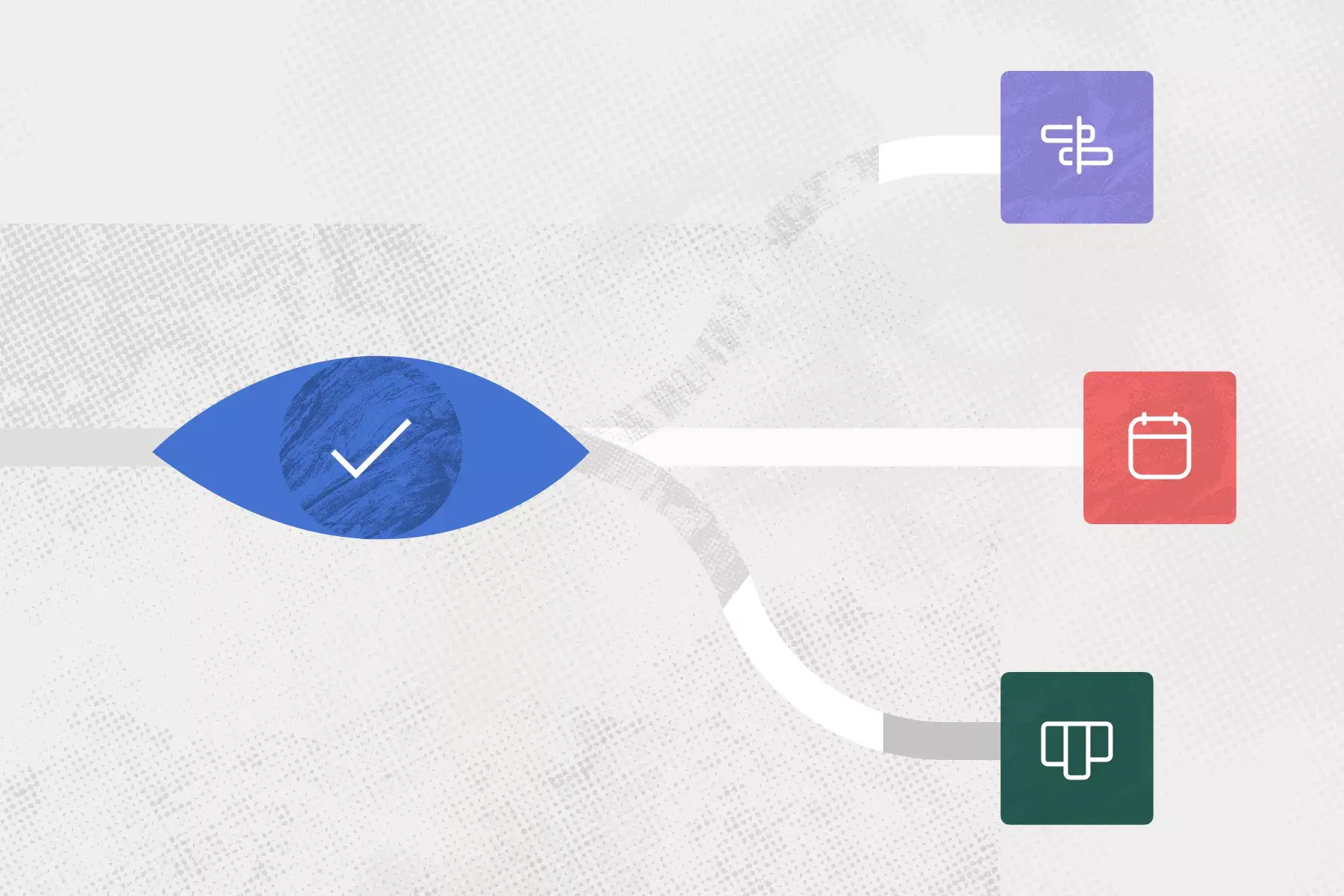
3 visual project management layouts (and how to use them)

Grant management: A nonprofit’s guide
Advisory boards aren’t only for executives. Join the LogRocket Content Advisory Board today →

- Product Management
- Solve User-Reported Issues
- Find Issues Faster
- Optimize Conversion and Adoption
An overview of the 8D problem-solving method
The 8D problem-solving method is a powerful tool in product management. It’s designed to help product managers tackle issues systematically and enhance product quality. This method follows eight steps in total, hence the name 8D.
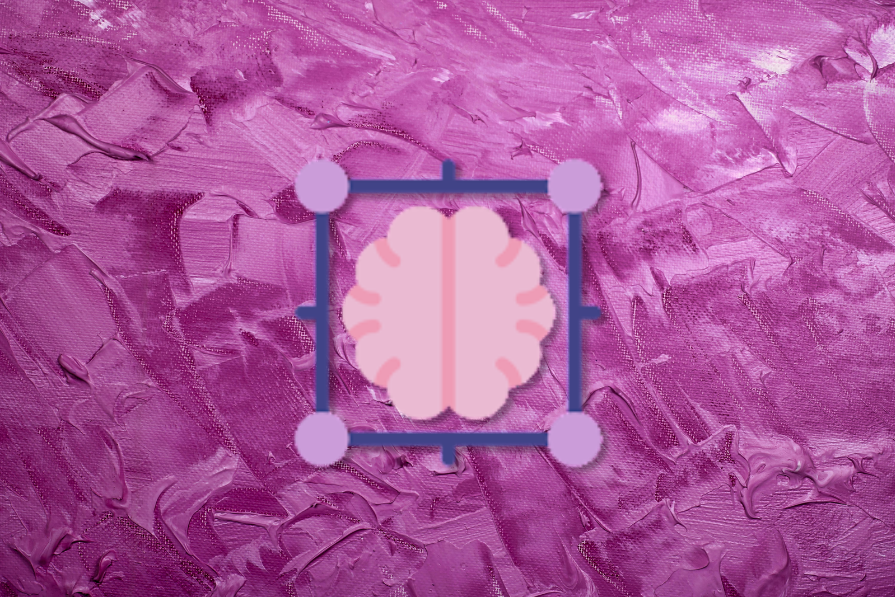
The steps range from identifying problems to implementing long-term solutions. Today you’ll explore how you can effectively apply 8D to your products. You’ll also learn about the benefits of using this approach and analyze some real case studies.
What is 8D?
The 8D problem-solving method is designed to address and resolve problems by identifying, correcting, and eliminating recurring issues.
It involves eight different steps:
- Plan — Prepare for the problem-solving process
- Team selection — Assemble a team with the necessary knowledge and skills
- Problem definition — Clearly define the problem and its impact
- Interim containment action — Implement temporary measures to contain the problem
- Root cause identification — Identify the underlying cause(s) of the problem
- Permanent corrective action — Develop and implement a solution to address the root cause
- Preventive measures — Take steps to prevent the recurrence of the problem
- Team recognition — Acknowledge and reward the team’s efforts in resolving the issue
These steps focus on root cause analysis, preventive measures, and long-term solution implementation. The end goal is to improve product quality and operational efficiency.
The eight disciplines of 8D
The eight disciplines of the 8D method represent a comprehensive approach to solve problems within an organization. Each discipline is designed to guide teams through the process at each stage. Here’s a deeper look into each stage:
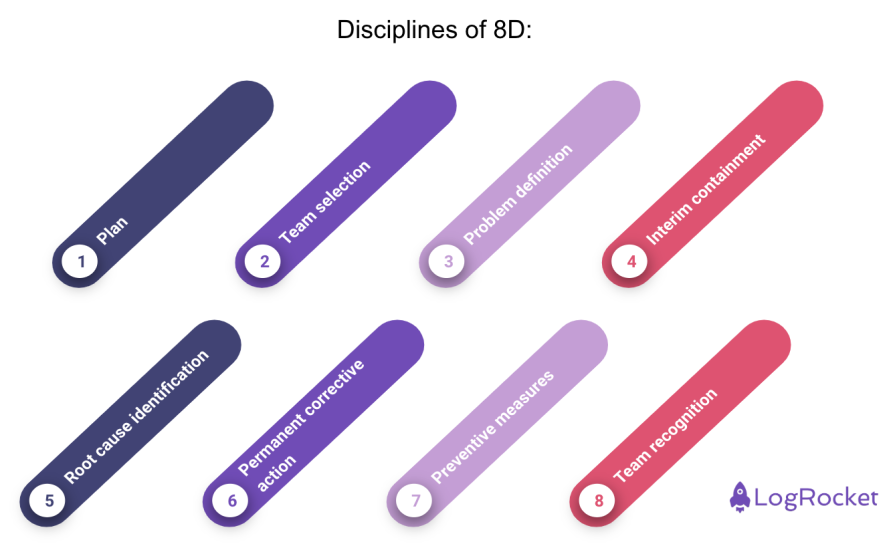
This initial step involves preparing for the problem-solving process. The goal here is to understand the problem’s magnitude and set up objectives. It’s about getting ready to tackle the issue systematically.
Team selection
In this step, a cross-functional team is formed. The team should consist of individuals with the necessary knowledge, skills, and experience to address the problem effectively. The team works together throughout the 8D process.
Problem definition
Next, the team has to describe the issue in specific terms. The goal here is to understand the impact and scope of the complication. A well-defined problem is easier to solve.
Interim containment
In the process of finding a solution, temporary measures are taken to contain the problem and prevent it from worsening. This reduces further damage or impact to the involved operations.
Root cause identification
In this phase, the team uses various tools and techniques to identify the underlying cause of the problem. An understanding of the root cause is essential for developing an effective, lasting solution.
Permanent corrective action
With the root cause identified, the team moves to develop a permanent corrective action plan to resolve the issue. Now, the team needs to choose the best solution, implement it, and monitor its effectiveness. This analysis will ensure that the problem is truly resolved.

Over 200k developers and product managers use LogRocket to create better digital experiences
Preventive measures
With such vast processes, there is always a possibility of the problem recurring. To resolve this, the team identifies and implements measures that address the root cause. There might be a need for changes to different aspects of the overall approach.
Team recognition
The final stage focuses on acknowledging and rewarding the team’s efforts. Recognizing the team’s hard work and success in resolving the issue is important for morale. It also promotes a culture of continuous improvement.
By following these eight disciplines, product managers can solve problems more effectively. The other benefit is that it builds a proactive culture that addresses issues before they escalate.
Applying 8D in product management
Applying the 8D problem-solving method in product management involves leveraging its structured approach. This helps you eliminate problems and process improvement initiatives.
Problem identification
The 8D process begins with gathering data and feedback to quickly identify potential issues. After that, a diverse team from various departments works together to uncover issues. And finally, the team solves the problems efficiently.
Once a problem is spotted, quick fixes are applied to limit its impact. Simultaneously, you explore root causes of an issue using methods like the Five Whys . The final step is to implement the solution based on these insights. Occasionally, redesigns or process upgrades are also used to resolve the issue thoroughly.
Elimination
To eliminate recurring problems, it’s crucial to establish preventive measures. Several steps support the main goal of elimination including process adjustments, quality control improvements, and updates to design standards.
The insights gathered from each 8D cycle help with continuous improvement. It also aids in formulating strategies to avert future issues.
Benefits of the 8D method
The main benefit of using the 8D method is its impact on teamwork and continuous improvement. The more obvious benefits focus on root cause analysis and prevention of issues:
- Enhanced quality control
- Efficient problem resolution
- Systematic and thorough approach
- Teamwork and knowledge sharing
- Focus on root cause analysis
- Reduced recurrence of issues
- Cost reduction
- Improved customer satisfaction
The systematic approach to address issues ensures that no effort goes to waste. Eventually, it helps the teams to quickly propose long-term solutions to a range of problem patterns.
Challenges in implementing 8D
The 8D problem-solving method is extremely valuable when used in the right manner. However, there can be challenges at every stage of this process. Because of this, it’s beneficial for you to have an understanding of how to quickly identify these challenges.
These include:
- Resistance to change among team members
- Insufficient teamwork and collaboration
- Lack of training on the 8D methodology
- Difficulties in data collection and analysis
How to solve them?
- Clearly communicate benefits to overcome resistance
- Foster collaboration and teamwork among participants
- Provide targeted training on the 8D process
- Encourage data analysis for effective problem-solving
For a deeper understanding, let’s take a look at two case studies of how the 8D process can enhance the product management workflow.
Real-life examples of 8D
A leading tech company, (similar to Apple) faced public backlash over smartphones overheating and reduced battery life. In this context, the 8D method helped to quickly identify and contain the issues.
The root cause analysis helped it track the problem back to a battery design flaw. Collaborative efforts with the battery supplier led to a redesigned battery and an update to the operating system. This not only resolved the issue but also restored consumer trust. Eventually, the brand’s reputation for quality was restored.
Similarly, a major automaker found a software glitch in its driver-assistance systems. This issue was risking driver safety. Using the 8D method, it pinpointed outdated algorithms as the root cause. The solution was simple, it issued a software update and enhanced its development processes.
Both of these examples are evidence of how the 8D method can be utilized to prevent complications efficiently.
Key takeaways
In wrapping up, it’s clear that this approach is more than just a procedure. Think of it as a strategic framework designed for the product manager. The 8D method equips you with a robust toolkit for addressing and preempting issues, systematically.
On top of that it helps you to:
- Promote teamwork and continuous improvement
- Reduce problem recurrence through root cause analysis
- Overcome implementation challenges with effective communication
Feel free to comment with any questions you may have!
Featured image source: IconScout

LogRocket generates product insights that lead to meaningful action
Get your teams on the same page — try LogRocket today.
Share this:
- Click to share on Twitter (Opens in new window)
- Click to share on Reddit (Opens in new window)
- Click to share on LinkedIn (Opens in new window)
- Click to share on Facebook (Opens in new window)
- #agile and scrum
- #project management

Stop guessing about your digital experience with LogRocket
Recent posts:.

Drive growth with these 7 customer feedback tools
A customer feedback tool is a software solution or platform designed to collect, analyze, and manage feedback from customers.

Leader Spotlight: Motivating teams to hit customer-centric outcomes, with Kristina Bailey
Kristina Bailey discusses the careful balance of knowing the business outcomes you want to achieve while balancing customer outcomes.

Exploring augmented products: Beyond the core offering
Augmented products leverage technology and additional services to provide enhanced functionality, convenience, and value to users.

A guide to acceptance test-driven development (ATDD)
ATDD is an agile methodology involving collaboration to define acceptance criteria before starting any development.

Leave a Reply Cancel reply

Mastering the 8D Problem Solving Method: A Comprehensive Guide

It is often said that “a stitch in time saves nine.” Efficient problem-solving is an essential skill , especially in a professional environment.
When it comes to addressing complex issues, the 8D Problem Solving method has gained significant traction across various industries. In this comprehensive guide, we will explore the 8D Problem Solving method, its history, and its application across multiple sectors.
History of the 8D Problem Solving Method
The 8D Problem Solving approach has its origins in World War II when the American military was under intense pressure to produce reliable weapons as quickly as feasible.
The military established a methodical approach to problem-solving, focusing on quality control and continual improvement, to ensure that resources were used effectively.
This was the first instance of what would later develop into the 8D technique.
The writings of Walter Shewhart , W. Edwards Deming , and Joseph M. Juran , who set the groundwork for contemporary quality control and continuous improvement ideas, had a substantial impact on the development of the 8D Problem Solving approach.
These guidelines stress the value of data-driven decision-making and the necessity for businesses to take a pro-active approach to problem-solving.
The Ford Motor Company faced intense competition from Japanese automakers in the 1980s, which caused it to struggle.
Ford used quality control and continuous improvement as its guiding principles and included the 8D Problem Solving process into its business practices to regain its footing.
The automobile sector adopted the 8D methodology widely as a result of the initiative’s success.
The 8D Problem Solving approach gained popularity outside of the automobile industry as it showed continuous promise.
The 8D methodology is now being used by businesses in a variety of industries, such as manufacturing, healthcare, and technology, to solve complicated issues, enhance their operations, and guarantee customer happiness.
The 8D Problem Solving approach has attained widespread acceptance throughout a number of industries.
It is a potent tool for businesses looking to improve their problem-solving skills and promote long-term success due to its systematic approach, emphasis on teamwork, and emphasis on continual improvement.
The Eight Disciplines of 8D Problem Solving

D1: Form a Team
Assembling a diverse team with relevant expertise
The first phase in the 8D process is to put together a varied team of people with the necessary knowledge, making sure that all viewpoints and skill sets are represented. This multidisciplinary approach makes it easier to recognize problems and produce creative solutions.
Defining roles and responsibilities
The tasks and responsibilities of each team member must be established once the team has been constituted. Team members can work cooperatively and effectively by setting clear expectations, ensuring that everyone’s abilities are utilized to the utmost extent. It keeps the problem-solving process on track and upholds accountability.
D2: Define the Problem
Accurate problem description
Accurately characterizing the current problem is the second discipline of the 8D technique. In order to do this, the team must acquire pertinent data, analyze it, and create a clear, succinct statement describing the problem. A focused and efficient problem-solving approach is built on a well identified problem.
Gathering data and identifying root causes
To create long-lasting solutions, the problem’s underlying causes must be determined. The team must gather information from a variety of sources, such as consumer feedback, product testing, or process performance measurements, in order to accomplish this. The team is able to uncover patterns, trends, and potential fundamental causes thanks to this data-driven approach, which also ensures that the problem-solving procedure is unbiased and grounded in facts.
D3: Develop an Interim Containment Plan
Quick, temporary solutions
Minimizing the effects of a problem is crucial in the field of problem solving. Creating an interim containment strategy, which offers quick, temporary solutions to the issue, is the third discipline in the 8D technique. These quick fixes aid in limiting the harm, stopping more problems, and buying the team some time while they produce a more long-term fix.
Mitigating damage and preventing further issues
It is essential to keep an eye on the interim containment plan’s efficacy and adjust as necessary as you go. This guarantees that the short-term fix works to contain the harm and stop the issue from getting worse. Any lessons learnt during this phase should also be recorded by the team because they will be helpful in creating the ultimate corrective action.
D4: Identify Root Causes

Root cause analysis techniques
The fourth discipline of the 8D technique entails examining the issue more closely in order to determine its underlying causes. Various root cause analysis methods, including the Five Whys, Fishbone Diagram, and Fault Tree Analysis, must be used in this situation. The team may create focused solutions that address the issue at its source rather than just treating its symptoms by determining the fundamental causes of the problem.
Verifying root causes through data
Verifying potential root causes with data is crucial after the team has discovered them. Taking this step, the team can avoid being misled by assumptions or unrelated elements and instead concentrate on the real core cause. The team may be confident that their suggested remedies will be successful in tackling the problem by validating the main causes using data.
D5: Choose and Verify Permanent Corrective Actions
Developing and evaluating potential solutions
The team can now consider various solutions after determining the root reasons. “Two heads are better than one,” as the saying goes, and this collaborative process frequently produces innovative and useful ideas. The team should assess each alternative after producing a list of potential corrective actions based on elements including feasibility, cost, and potential impact. This makes it more likely that the selected solution will be both workable and efficient.
Implementing and verifying chosen solution
It’s crucial to assess the effectiveness of the chosen solution before fully applying it. A small-scale trial or a pilot program can be used to accomplish this. The team may be certain that their selected corrective action will be successful when used on a bigger scale by confirming the solution’s success in resolving the issue.
D6: Implement Permanent Corrective Actions
Developing a detailed action plan
The team must create a thorough action plan for putting the selected solution into practice when it has been verified. This strategy should specify the actions, materials, and timetable required for a full integration of the solution into the organization’s operations. A comprehensive action plan makes for an effective implementation that minimizes any hiccups or setbacks.
Monitoring implementation and adjusting as needed
It’s essential to keep an eye on the permanent remedial action’s development and adjust, as necessary. The team may make sure that the solution is properly integrated and produces the required results by remaining alert and reacting to any unforeseen obstacles.
D7: Prevent Recurrence
Identifying potential future issues
The 8D method’s seventh discipline focuses on predicting prospective problems that might develop in the future from comparable underlying causes. The team can help to prevent repeat incidences and continuously enhance the organization’s procedures by foreseeing and addressing these possible issues.
Adjusting processes and procedures to prevent recurrence
The team should analyze and make any necessary modifications to the organization’s systems and procedures to stop the issue from happening again. This can entail creating new quality control procedures, updating the documentation, or changing the training materials. Implementing these changes, the company can promote a climate of continuous development and make sure that the lessons discovered throughout the problem-solving procedure are incorporated into every aspect of its day-to-day work.
D8: Congratulate the Team
Recognizing team achievements
It’s important to acknowledge the team’s effort and commitment when the 8D technique has been implemented successfully. Celebrating their accomplishments promotes a sense of ownership, boosts morale, and encourages continuing commitment to ongoing growth.
Sharing lessons learned with the organization
The team should share their lessons learned with the broader organization. Doing so, they can help to disseminate the knowledge gained during the problem-solving process, fostering a culture of learning and improvement throughout the company.
Practical Application of the 8D Problem Solving Method

Numerous industries, including aerospace, automotive, healthcare, manufacturing, and technology, have successfully used the 8D Problem Solving method. These actual instances show how adaptable and successful the system is at solving a variety of challenging issues .
Although the 8D method offers a structured approach to problem-solving, it is crucial to customize the procedure to the particular requirements and context of the current problem.
This could entail modifying the chronology, modifying the root cause analysis methods, or adding new data sources.
The team can ensure the most efficient problem-solving procedure by continuing to be adaptable and flexible.
Tips for Successful 8D Problem Solving Implementation

Emphasizing clear communication
Clear communication is the lifeblood of effective problem-solving.
Throughout the 8D process, the team should prioritize open and honest communication, ensuring that all members have a thorough understanding of the problem, the chosen solution, and their individual responsibilities.
Fostering a culture of collaboration and continuous improvement
A collaborative and improvement-focused culture is key to the success of the 8D method.
Encouraging open dialogue, mutual support, and ongoing learning, the organization can create an environment in which the 8D method can thrive.
Employing project management tools and techniques
Project management tools and techniques can be invaluable in facilitating the 8D process.
Using tools such as Gantt charts, project management software, or Kanban boards, the team can better track progress, allocate resources, and manage timelines.
These tools can help to keep the problem-solving process organized and efficient, ensuring that the team stays on track and achieves their goals.
Final Thoughts
The 8D Problem Solving method is an effective and adaptable way for tackling complicated challenges in a variety of industries.
Organizations may methodically identify and address problems, stop them from happening again, and promote a culture of continuous improvement and adhering to the eight disciplines.
As we’ve seen, the 8D method’s effectiveness depends on putting together a varied team, upholding clear communication, customizing the procedure for particular circumstances, and using efficient project management tools and approaches.
We urge you to use the 8D Problem Solving method inside your organization now that you have a thorough understanding of it.
Doing this, you may not only address issues more quickly, but also unleash the long-term growth potential of your company.
If you can master the 8D approach, your business will have a better future and you’ll be well-equipped to traverse the waters of problem-solving.
Q: What is the 8D Problem Solving method?
A : A systematic strategy for addressing complicated challenges across multiple industries is the 8D Problem Solving method. It consists of eight disciplines that help firms recognize problems, find solutions, stop them from happening again, and promote a continuous improvement culture.
Q: What are the origins of the 8D Problem Solving method?
A : The United States military created a systematic approach to problem-solving during World War II that was centered on quality control and continual improvement, and this is where the 8D technique got its start. The Ford Motor Company later adopted and promoted the technique in the 1980s.
Q: What are the eight disciplines of the 8D Problem Solving method?
A : The eight disciplines of the 8D method are
- Form a Team
- Define the Problem
- Develop an Interim Containment Plan
- Identify Root Causes
- Choose and Verify Permanent Corrective Actions
- Implement Permanent Corrective Actions
- Prevent Recurrence
- Congratulate the Team
Q: How can the 8D method be applied across different industries?
A : The 8D method is adaptable and may be used to solve a wide variety of complicated problems in a number of different industries, including manufacturing, aerospace, automotive, healthcare, and technology. Organizations should modify the process to match the particular requirements and context of the current challenge in order to utilize the 8D technique effectively.
Q : What are some tips for successfully implementing the 8D Problem Solving method?
A : To ensure the success of the 8D method, organizations should
- Emphasize clear communication.
- Foster a culture of collaboration and continuous improvement.
- Employ effective project management tools and techniques .
Q: What is the role of root cause analysis in the 8D method?
A : The 8D method’s key element is root cause analysis, which identifies the root reasons of an issue. Organizations can create focused solutions that solve the issue at its foundation rather than just masking the symptoms by addressing the root causes.
Q: How can the 8D method help prevent the recurrence of problems?
A : By recognizing potential future issues that may result from comparable root causes and modifying processes and procedures accordingly, the 8D technique aids in preventing the recurrence of problems. This proactive strategy assists companies in making continuous improvements and reducing the possibility that similar issues will arise again.

Ronnie Patterson
Ronnie Patterson, founder of MagnÜron, is a multifaceted entrepreneur with a diverse background in music, electronics engineering, and engineering management. Drawing on experience across various industries, He offers expertise in SEO, operations, and strategy to help businesses thrive. Possessing a unique perspective and unwavering commitment to collaboration, and ideal partner for growth and success.
Similar Posts

Conversion Rate Optimization (CRO) Essentials: Amplify Your Website’s Impact
CRO Conversion Rate Optimization

Unlocking the Game: 15 Impactful Leadership Competencies
Leadership competencies is more critical than ever. Leadership competencies, which…

E-commerce Analytics for Data-Driven Decision Making: 7+ Key Steps
Businesses must harness the power of data and analytics to…

Streamlining Your Small Business Finances: Financial Management Tips and Reporting
Effective financial management is essential for every small business to…

Virtual Events: A Guide for Businesses
Businesses are increasingly leveraging the power of virtual events to…

How to Start a Party Planning Business: Tips and Advice
Are you a whiz at party planning? Do you love…
How to Use the 8D Method to Find the Root Cause of Nonconformances

The 8D method, also known as the 8 Disciplines, first appeared in Ford’s 1987 Team-Oriented Problem Solving manual. It’s a tool that’s stood the test of time, becoming the main problem-solving method used in the company, today called Global 8D.
Even though the 8D approach has been around for more than thirty years, many companies still struggle with ineffective problem-solving and weak implementation of corrective action.

Before you take any action to solve the problem, you need a plan to identify the appropriate people and resources for the job. At a minimum, your plan should include:
- A basic description of the problem
- Timeframe for resolving the problem based on risk
- Any resources needed
D1: Form Your Team
Creating the team who conducts the 8D problem-solving process is a weak point for many organizations. It’s critical to include people from the department in question, since you can’t solve a problem without those who have first-hand knowledge of it.
If it’s a part problem, the engineer responsible for design should be on the team. If it’s a production issue, you’ll want to loop in the supervisor from the specific work area. Just don’t make the mistake of thinking 8D is a paperwork exercise a quality person can complete from their desk.
D2: Define the Problem
This step involves gathering details and data to describe the problem completely, another area where people have a lot of trouble. Defining the problem could mean a Gemba walk to observe the problem on the shop floor, analyzing quality data and/or using is/is-not analysis to more precisely define the issue.
As much as possible, try to describe and quantify the problem in terms of:
D3: Contain the Problem
Temporary containment minimizes the impact of the problem while you develop permanent solutions, and is especially important where product quality or safety is at risk. In some cases, you may need new processes to route around the problem until you have a permanent fix.
Many auto manufacturers make the error of stopping at this point, confusing containment for corrective action. Sorting mixed parts or cleaning up a mess addresses only the symptoms of the problem, not its root cause. The result: repeat problems, rising costs and potential loss of business.
D4: Identify the Root Cause
With the problem temporarily contained, you can now turn to analyzing the root cause of the nonconformance. Widely used methods include:
- The 5 Whys to dig into successfully deeper layers of the problem
- Fishbone diagramming to visually categorize causes during brainstorming
- Pareto charts to identify the vital few causes
Beyond simply generating hypotheses, you need to verify the root cause with key stakeholders, audits and/or statistical data when possible.
D5: Analyze and Select Corrective Actions
After your team has determined the root cause of the problem, you’re now in a position to identify what the best long-term solution is.
Brainstorming sessions combined with tools like affinity diagrams can help organize ideas based on their relationships and determine the most effective course of action.
D6: Implement and Validate Corrective Actions
It’s worth noting that six steps into the 8D method is when you’re finally ready to implement the corrective action, highlighting the key role of planning in this method.
Management needs to be an active participant in verifying implementation of corrective actions. That means they need to be a visible presence both on the shop floor and in regular reviews of key performance indicators (KPIs) to measure effectiveness. Leadership needs to set an example, examining processes through the eyes of the customer paying the bills.
Verification could also involve tools like accelerated life testing to simulate conditions that could lead to failure. If the problem has multiple dimensions, perform steps D4 through D6 until you can verify your corrective actions have addressed the problem as a whole.
D7: Implement Preventive Actions
Many companies rush to close the file on corrective actions, but real change only happens when you apply lessons learned to other areas to prevent future problems. For instance, if you fix one piece of equipment, but the same problem could occur on several other machines, the corrective action was not sustainable.
At this step, you’ll want to consider actions such as:
- Updating process audit questions based on corrective actions to reduce risk in other processes and periodically verify corrective action is still in place
- Introducing poka-yoke or error-proofing devices to high-risk processes
- Performing red rabbit tests to see how long it takes poka-yoke devices to detect defective product
D8: Recognize Your Team
After all that work, don’t forget to recognize the team. Whether it’s a financial bonus, special event or simply mentioning the team in a meeting or newsletter, this step is critical to building a culture of quality.
Because at its core, quality culture requires active participation from top management to front-line operators. And that kind of engagement—the kind where people take personal ownership of quality—is only possible when people can see that their actions have an impact.
Related articles
Problem Solving and Root Cause Analysis C1887
Topics: Quality, Safety & Maintenance
This course is verified by Probitas as meeting the AS9104/3A requirements for Continuing Professional Development.
Problems arise in all facets of life. This is particularly true in the business world. Problems impact all aspects of an organization’s operations such as; product development, product quality, process efficiency, marketing efforts, human relations, leadership efforts, financial execution and ultimate profitability. If these problems are not addressed, they inhibit the operation of the business and can eventually result in total failure. The ways in which problems are addressed, and the methodologies employed, determine the probability of successful problem resolution.
This course provides an overview of successful problem-solving models and guides the participants through the steps for effective problem resolution. The 8D problem-solving model embodies all of the essential steps for effective team-based problem solving. The 8D model is employed in this training program to demonstrate the use of basic tools and concepts. Problem solving requires: data gathering, data analysis and ultimately new patterns of thought for resolution of problems and prevention of new problems. There are numerous effective tools to aid in the handling of data and generating effective solutions. In addition to presenting an effective problem-solving model this course presents the use of selected tools that support the problem-solving effort.
Root Cause Analysis is an essential component to all problem-solving methodologies. Many have said that once a problem is well defined and a root cause is identified, the problem is essentially solved. A central focus of this course is generating the proper environment for identifying the root cause and use of a wide array of tools that support root cause analysis.
During this course participants will address the real business/technical problems that stand in the way of their organization’s success. The pathway for resolution of these problems is developed and, in many instances, actual solutions are generated in the classroom.
Learning Objectives
- Define the term “problem” and describe why we need a structured problem-solving approach
- Identify the requirements for each step of a basic systematic and effective approach to problem solving and root cause analysis
- Effectively select and apply problem solving and root cause analysis tools
- Correctly and effectively apply the basic problem solving and root cause analysis approach on real company problems
Who Should Attend
Management and technical personnel from all areas of the business including but not limited to: Senior Management, Department Heads, Engineers, Designers, Quality Managers/Engineers/Technicians, HR Managers/Administrators, Production Supervision and Other Operations personnel.
You must complete all course contact hours and successfully pass the learning assessment to obtain CEUs .
For additional information, contact SAE Customer Service 1-877-606-7323 (724-776-4970 outside the U.S. and Canada) or at [email protected] .
Curtis Pawloski

Certifications:
- American Society for Quality Certified Quality Engineer
- ASME Certified Senior GD&T Professional
Fees: $1349.00
If paying by any other method or if you have general questions, please contact SAE Customer Service.
The Evolution of 8D Problem-Solving: From Basics to Excellence
- Learn Lean Sigma
- 8D Problem Solving
In a world where efficiency and effectiveness are more than just buzzwords, the need for robust problem-solving methodologies is greater than ever. Among the myriad of approaches that organizations adopt to tackle challenges, the 8D Problem-Solving framework stands as a testament to both versatility and efficacy. Originating from military standards and later popularized by the automotive industry, 8D has evolved to become a universal tool for identifying issues, analyzing root causes, and implementing sustainable solutions.
This blog post aims to guide you through the captivating history and evolution of the 8D Problem-Solving approach. From its early days as a checklist in quality management to its modern adaptation using advanced statistical tools and cross-industry applications, we’ll explore how 8D has transformed into a comprehensive, adaptable, and highly effective method for tackling problems in various sectors. Whether you’re new to 8D or looking to deepen your understanding, this article offers valuable insights into its development and current applications.
Table of Contents
The genesis: where it all began, the military origins.
The very first seeds of the 8D Problem-Solving methodology were sown during World War II. It was incorporated into Military Standard 1520, a framework aimed at addressing product and service failures. At the time, the military faced complex challenges that often involved multiple variables and high stakes. These challenges required a disciplined approach to problem-solving that could help identify and eliminate the root causes of failures.
Limited Initial Reach
Despite its structured approach, the method had limited reach and was not extensively used outside military applications. This was primarily due to two reasons:
- Specificity : The original framework was tailored for military applications, which made it less relatable to civilian industries.
- Complexity : The depth of the method often required specialized training, which acted as a barrier for broader adoption.
The Automotive Revolution: Ford Takes the Wheel
Fast forward to the 1980s, and the landscape of quality management began to change. Companies were increasingly focusing on systematic approaches to problem-solving and continuous improvement. It was during this era that the 8D Problem-Solving approach got a second life through its adoption by the Ford Motor Company.
Ford was facing growing competition and realized the need for a structured, repeatable problem-solving methodology. The 8D framework fit the bill perfectly, as it provided a step-by-step approach to identify issues, analyze their root causes, and implement corrective measures.
Standardization and Beyond
Once Ford demonstrated the success of implementing the 8D methodology, it became part of the larger Quality Management Systems. Organizations began to see the value in a disciplined approach to problem-solving, and thus, 8D started its journey towards standardization and broader industrial application.
By embracing quality management principles like ISO 9001, the 8D approach transformed from a ‘military-specific’ solution to a universally applicable method for problem-solving. This was a pivotal moment in its history, paving the way for the methodology’s future evolutions and its adoption across diverse sectors.
The origin story of 8D Problem-Solving is a compelling tale of adaptation and evolution. From its military roots to its mainstream industrial applications, the methodology has proven its mettle in solving complex problems methodically and effectively.
The 8 Disciplines: A Quick Overview
Understanding the 8 Disciplines that make up the 8D Problem-Solving approach is crucial for comprehending its comprehensive nature. For a comprehensive guide on how to navigate each of the eight disciplines, you can visit Learn Lean Sigma’s 8D Problem Solving Guide .
Here’s a brief rundown:
This is the preparatory stage where you outline the scope of the problem and plan the resources required for the problem-solving process.
D1: Team Formation
A cross-functional team is assembled with individuals who have the skills and knowledge needed to solve the problem effectively.
D2: Problem Description
The issue at hand is clearly defined, often using tools like the 5W2H (Who, What, When, Where, Why, How, How much) to ensure everyone understands it.
D3: Interim Containment Actions
Temporary actions are taken to contain the problem and prevent it from causing immediate harm while the root cause is being investigated.
D4: Root Cause Analysis
Through data collection and analysis, the underlying cause of the problem is identified. Methods like the Fishbone Diagram or 5 Whys are commonly used.
D5: Permanent Corrective Actions
Once the root cause is known, permanent solutions are developed and tested to ensure they effectively solve the problem.
D6: Implement and Validate Solutions
The validated solutions are fully implemented. Metrics are set up to monitor the effectiveness of the solutions over time.
D7: Preventive Measures
Actions are taken to prevent the recurrence of the problem in the future. This often involves updating procedures or training.
D8: Closure and Team Celebrations
The project is formally closed, and the team’s efforts are recognized and celebrated, often leading to increased motivation for future projects.
These eight disciplines provide a structured, step-by-step approach to problem-solving, ensuring that issues are not just solved but also prevented from recurring.
Would you like to know how each of these disciplines integrates with modern tools and methodologies like Lean Six Sigma? Stay tuned for more in-depth articles on this topic.
The Evolutionary Milestones of 8D Problem-Solving
1. initial adoption and standardization, the checklist era.
In its formative years, the 8D methodology was primarily a checklist approach to problem-solving. Organizations used it as a guide to ensure that they didn’t miss critical steps in the problem-solving process. While effective, it lacked the rigor and structure to be universally adopted as a standard.
Integration into Quality Management Systems
The game-changer came when 8D was integrated into Quality Management Systems like ISO 9001. This move provided the methodology with the structure and standardization it needed to be widely accepted. It moved from being a simple checklist to a deeply structured, documented process that required evidence-based actions at every stage.
2. Cross-Industry Application
Breaking industry barriers.
By the late 1990s and early 2000s, the 8D methodology began to show its versatility. What started in the automotive and military sectors soon found applications in healthcare, FMCG, logistics, and even software development.
Universal Principles
The universality of its principles meant that it could provide a structured way to approach problem-solving in different settings. The discipline it instilled in the process made it a favorite across industries, proving that good problem-solving techniques are not confined by industry boundaries.
3. Integration with Other Methodologies
The synergistic approach.
In more recent years, 8D has been combined with other methodologies like Six Sigma, Kaizen, and Lean. This integration has made the process far more robust, marrying the structured approach of 8D with the data-driven and continuous improvement aspects of these methodologies.
Enhanced Problem-Solving
For instance, integrating Six Sigma techniques into the Root Cause Analysis stage (D4) has allowed for a more sophisticated and accurate identification of root causes, making the solutions more effective and sustainable.
4. Technological Enhancements
The data revolution.
The advent of advanced statistical tools and software has significantly impacted the 8D methodology. Data analytics platforms and specialized software have made the data analysis phase far more sophisticated, improving the accuracy and efficiency of the entire process.
5. Adaptation for Smaller Issues
Quick 8d and micro 8d.
Recognizing that not every problem requires a full-blown 8D approach, the methodology has been adapted into “Quick 8D” or “Micro 8D” versions. These are less resource-intensive and can be implemented much quicker, making 8D accessible for smaller issues without sacrificing the integrity of the problem-solving process.
The 8D Problem-Solving methodology has shown remarkable adaptability and resilience, evolving over the years to meet the demands of a rapidly changing industrial landscape. Each evolutionary milestone has added layers of effectiveness, making it a reliable choice for organizations aiming for excellence in problem-solving.
Modern-Day Applications and Case Studies of 8D Problem-Solving
The 8D Problem-Solving methodology has come a long way from its military and automotive roots. Today, it has been adopted by a variety of industries and sectors, demonstrating its versatility and effectiveness in solving a wide range of problems. Below are some noteworthy applications and case studies.
Service Industries
Hospitality sector.
In the hospitality sector, 8D has been employed to improve customer satisfaction and operational efficiency. For example, a hotel chain used 8D to identify the root cause of frequent customer complaints about room cleanliness, eventually implementing new training programs for housekeeping staff.
Hospital Operations
Hospitals have applied 8D to solve problems related to patient safety, medical errors, and operational bottlenecks. One case study from a leading hospital showcased how 8D helped reduce the time required for the emergency room triage process, thus saving lives.
Software Development
Debugging and quality assurance.
In software development, 8D has found a place in debugging and quality assurance phases. It helps teams systematically identify, analyze, and resolve software bugs, leading to more reliable products.
Manufacturing Giants and Their Case Studies
General electric.
GE used the 8D methodology to improve the reliability of their turbine engines. After identifying the root cause of frequent failures, they implemented corrective actions that increased the lifespan of the engines, saving both time and resources.
Toyota, a name synonymous with quality and efficiency, has frequently turned to 8D for solving complex engineering and manufacturing challenges. One documented case study revealed how Toyota used 8D to reduce the defect rate in one of its assembly lines, thus improving productivity and quality.
In the consumer electronics industry, Samsung employed 8D to tackle the battery issues plaguing its Galaxy Note series. By systematically identifying the root cause, Samsung was able to implement corrective actions that restored consumer trust in their products.
The wide-ranging applications of 8D in various industries underscore its flexibility and robustness as a problem-solving methodology. These case studies are not just isolated examples; they are a testament to the adaptability and efficacy of the 8D approach in solving real-world problems.
The 8D Problem-Solving methodology has undergone a remarkable journey, evolving from its origins in military applications to becoming a universally adopted framework across a spectrum of industries. Its structured, step-by-step approach not only solves immediate issues but also lays down preventive measures to avoid future occurrences. This adaptability is evidenced by its successful implementation in sectors as diverse as healthcare, software development, and manufacturing.
Companies like General Electric, Toyota, and Samsung have leveraged 8D to drive impactful changes, highlighting the methodology’s potential for fostering organizational excellence. As we move forward in an increasingly complex and dynamic world, the 8D approach will undoubtedly continue to be a cornerstone for effective problem-solving and continuous improvement.
- Zarghami, A. and Benbow, D.W., 2017. Introduction to 8D problem solving . Quality Press.
- Camarillo, A., Ríos, J. and Althoff, K.D., 2017. CBR and PLM applied to diagnosis and technical support during problem solving in the Continuous Improvement Process of manufacturing plants . Procedia Manufacturing , 13 , pp.987-994.
Daniel Croft
Daniel Croft is a seasoned continuous improvement manager with a Black Belt in Lean Six Sigma. With over 10 years of real-world application experience across diverse sectors, Daniel has a passion for optimizing processes and fostering a culture of efficiency. He's not just a practitioner but also an avid learner, constantly seeking to expand his knowledge. Outside of his professional life, Daniel has a keen Investing, statistics and knowledge-sharing, which led him to create the website learnleansigma.com, a platform dedicated to Lean Six Sigma and process improvement insights.
Scoping projects with SIPOC
5s floor marking best practices, free lean six sigma templates.
Improve your Lean Six Sigma projects with our free templates. They're designed to make implementation and management easier, helping you achieve better results.
In lean manufacturing, the 5S System is a foundational tool, involving the steps: Sort, Set…
How to Measure the ROI of Continuous Improvement Initiatives
When it comes to business, knowing the value you’re getting for your money is crucial,…
8D Problem-Solving: Common Mistakes to Avoid
In today’s competitive business landscape, effective problem-solving is the cornerstone of organizational success. The 8D…
In a world where efficiency and effectiveness are more than just buzzwords, the need for…
8D: Tools and Techniques
Are you grappling with recurring problems in your organization and searching for a structured way…
How to Select the Right Lean Six Sigma Projects: A Comprehensive Guide
Going on a Lean Six Sigma journey is an invigorating experience filled with opportunities for…
Root Cause Analysis and the 8D Problem Solving Bootcamp
Four rca approaches for permanent and effective corrective actions | includes fmea, vsm and seven basic quality tools.
Course Summary
In this course I will cover four broad strategies or approaches for Root Cause Analysis (RCA) and problem-solving: 1. Five Why's 2. Cause and Effect Diagram 3. A3 Problem Solving Approach 4. Eight Disciplines or 8D Problem Solving Approach Depending upon the complexity of the problem you can choose one of these approaches. While taking these approaches, there are many tools and techniques which could be applied. I will cover many such tools, for example: 1. Seven Basic Quality Tools (Cause and Effect Analysis, Flow Chart, Check Sheet, Pareto Chart, Scatter Plot, Control Charts and Histograms) 2. Descriptive Statistics (Mean, Mode, Median, Range and Standard Deviation) 3. Graphs and Charts (Box and Whisker Plot, Individual Value Plot, Bar Chart, Pie Chart, Bubble Chart, Matrix Plot, and Time Series) 4. Value Stream Mapping 5. Tools for D1 (Establish the Team): Team Roles, Team Stages, Conflict Management and Negative Team Behaviours 6. Tools for D2 (Describe the Problem): 5W2H, SIPOC, Gemba Walk and Stakeholder Analysis 7. Tools for D3 (Interim Containment): Identification and Traceability 8. Tools for D4 (Root Cause Analysis): Brainstorming, Nominal Group Technique and Affinity Diagram 9. Tools for D5 (Develop CA): Poka-yoke, Force Field Analysis, Control Plan and Benefit-Cost Analysis 10. Tools for D6 (Implement CA): Gantt Chart, RACI Matrix, Reports and Dashboard 11. Tools for D7 (Prevent Recurrence): FMEA
Course Curriculum
1. introduction.
- Download Section 1 Slides Start
- 1a Introduction to RCA Preview
- 1b RCA Common Approaches Start
- 1c Problem Solving Start
- Quiz - Introduction to RCA Start
Technique #1: Five Whys
- Download Section 2 Slides and Templates Start
- 2a Five Whys Intro Start
- 2b Five Whys Start
- 2c Five Whys Demo Preview
- Quiz - Five Whys Start
Technique #2: Cause and Effect Analysis
- Download Section 3 Slides and Resources Start
- 3a Fishbone Diagram Theory Start
- 3b Fishbone Diagram Excel SigmaXL Start
- 3c Fishbone Diagram Minitab Workspace Start
- Quiz - Cause and Effect Analysis Start
Technique #3: A3 Problem Solving Approach
- Download Section 4 Slides and A3 Templates Start
- 4a1 A3 Problem Solving Part 1 Start
- 4a2 A3 Problem Solving Part 2 Start
- 4b Is Is not analysis Start
- 4c1 Cause and Effects Analysis Start
- 4c2a Flow Chart Start
- 4c2b Flow Chart Demonstration Start
- 4c3a Check sheet Start
- 4c3b Check sheet Demonstration Start
- 4c4a Pareto Chart Start
- 4c4b Pareto Chart Demonstration Start
- 4c5a Scatter Plot Start
- 4c5b Scatter Plot Demonstration Start
- 4c6a Control Charts Part 1 Start
- 4c6b Control Charts Part 2 Start
- 4c6c Control Charts Part 3 Start
- 4c6d Control Charts Demo 1 Start
- 4c6e Control Charts Demo 2 Start
- 4c6f Control Charts Demo 3 Start
- 4c7a Histogram Start
- 4c7b Histogram Demo Start
- Quiz 1 - A3 Problem Solving Start
- 4d1 Graphs and Chart Introduction Start
- 4d2 Central Tendency Measurement Start
- 4d3 Dispersion Measurement Start
- 4d4 Descriptive Statistics Demo Start
- 4d5 Box and Whisker Plot Start
- 4d6 Box and Whisker Plot Demo Start
- 4d7 Individual Value Plot with Demo Start
- 4d8 Bar Charts Start
- 4d9 Bar Charts Demo Start
- 4d10 Pie Charts Start
- 4d11 Bubble Charts Start
- 4d12 Bubble Charts Demo Start
- 4d13 Matrix Plot with Demo Start
- 4d14 Time Series Start
- 4d15 Time Series Demo Start
- Quiz 2- A3 Problem Solving Start
- 4e1 Value Stream Map Introduction Preview
- 4e2 VSM - Times Start
- 4e3 VSM - Demo Start
- Quiz 3 - A3 Problem Solving Start
Technique #4: 8D Problem Solving Approach
- 5-00a-Eight D History Start
- 5-00b-Eight D Introduction Start
- 5-00c Problem vs Symptoms Start
- 5-00d When to use 8D Start
- 5-0a D0 Preparation Start
- 5-1a D1 Selecting the Team Start
- 5-1b D1 Team Roles Start
- 5-1c D1 Team Stages Start
- 5-1d D1 Team Conflicts Start
- 5-1e D1 Negative Team Dynamics - 1 Preview
- 5-1f D1 Negative Team Dynamics - 2 Start
- 5-1g D1 Team Action Log Start
- Quiz 1 - 8D Problem Solving Start
- 5-2a D2 Define the Problem Start
- 5-2b D2 5W2H Start
- 5-2c D2 SIPOC Start
- 5-2d D2 Gemba Walk Start
- 5-2e D2 Stakeholder Analysis Start
- 5-3a D3 Interim Containment Start
- 5-3b D3 Identification Traceability Start
- 5-4a D4 RCA Start
- 5-4b D4 Typical Root Causes Start
- 5-4c D4 RCA Tools Start
- 5-4d D4 Brainstorming Start
- 5-4e D4 NGT Start
- 5-4f D4 Affinity Diagram Start
- Quiz 2 - 8D Problem Solving Start
- 5-5a D5 Develop Permanent CAs Start
- 5-5b D5 Poka Yoke Start
- 5-5c D5 Force Field Analysis Start
- 5-5d D5 Control Plan Start
- 5-5e D5 Benefit Cost Analysis Start
- 5-6a D6 Implement CA Start
- 5-6b D6 Gantt Chart Start
- 5-6c D6 Gantt Chart Demo Start
- 5-6d D6 RACI Matrix Start
- 5-6e D6 RACI Matrix Demo Start
- Quiz 3 - 8D Problem Solving Start
- 5-7a D7 Prevent Recurrence Start
- 5-7b D7 FMEA Intro Start
- 5-7c D7 FMEA Demo Start
- 5-8a D8 Recognize Team Start
- Summary and 8D Template Start
- Quiz 4 - 8D Problem Solving Start

Sandeep Kumar
Sandeep Kumar has more than 35 years of Quality Management experience. He has worked as Quality Manager/Director on a number of projects, including Power, Oil and Gas and Infrastructure projects.
In addition, he provides consulting services to implement Lean Six Sigma to improve performance.
His areas of specialization include Quality Assurance, ISO 9001:2015, Lean, Six Sigma, Risk Management, QMS Audits, Supplier Quality Surveillance, Supplier Pre-qualification, Construction Quality, Mechanical Inspection and Quality Training.
Professional Qualifications:
His professional qualification/certifications include:
• ASQ-CSSBB, Certified Six Sigma Black Belt • ASQ-CMQ/OE Certified Manager of Quality/Organizational Excellence • PMI-PMP Certified Project Management Professional
• IRCA Registered Lead Auditor (QMS-2015)
• IIA-CIA Certified Internal Auditor • ASQ-CSSGB, Certified Six Sigma Green Belt
• ASQ-CQA Certified Quality Auditor
• ASQ-CQE Certified Quality Engineer
Course Pricing
$ 19.99 usd.
GET THE COURSE AT THE BEST PRICE. ANYTIME.
- 365 Day Subscription
- Certificate of Completion
© 2024 QualityGurus
- Terms & Conditions
- Privacy Policy
- Cookie Policy

Sign up for our newsletter!
Want to stay up-to-date on industry trends?
Accendo Reliability
Your Reliability Engineering Professional Development Site
by Ray Harkins Leave a Comment
Root Cause Analysis — What is 8D?

The “D” is 8D stands for “disciplines”, and the 8D process is a problem-solving methodology employing eight sequential disciplines or steps that can be applied to a wide range of industries, situations, and disciplines.
The 8D process was developed in the late 1980’s by the Ford Motor Company to give its engineers a standardized method for dealing with design and manufacturing problems. Ford’s predecessor to 8D was called “TOPS”, Team Oriented Problem Solving. This is a fitting name to the methodology since it strongly emphasizes a team-based approach. In fact, the first of the eight D’s is “Assemble the Team”.
The second D is “Describe the Problem”. As former president of General Motors, Charles Kettering tersely said, “A well-stated problem is half solved.” At this step of the process, the failure is analyzed, the data is collected, and the observations are made. This critical fact-finding phase sets the stage for the rest of the process.
The third D is the “Interim Containment Response”. These are the steps to “stop the bleeding”. Recalls, onsite sorting and 100% inspection typically fall under the umbrella of containment. In industries where a very high level of customer satisfaction is paramount, containment is often the most critical step in the process. While containment actions don’t fix problems, they do shield the customer from further effects of the supplier’s shortcoming.
The fourth D is “ Root Cause Analysis ”. This is where tools like capability analysis , the Ishikawa diagram , control charting, 5 Why Analysis, and Measurement System Analysis tie together the inputs of a process to the unintended outputs. By identifying the true root causes, your efforts moving forward to improve the process will yield your intended results.
The fifth D is “Determine the Corrective Action Plan”. This is the step where your understanding of the process, and your knowledge of improvement tools and strategies come together to permanently reduce or even eliminate the defect . It’s not good enough to just have a clear picture of the problem, you must have access to potential solutions as well. This access comes through experience, benchmarking , supplier support, established improvement strategies and a host of other sources.
The sixth D is closely related to the fifth, “Implement Corrective Actions ”. Even though the corrective action for a defect is accessible, it may take different types of effort to implement the right solution. This is where project management techniques, soft skills, and networking pay off most in the 8D process. Negotiating, planning, training and communicating often complement the “hard” skills of problem solving to fully implement the solution.
The seventh D is “Implement Preventive and Parallel Actions”. This is where the hard work you investing into the first six D’s is multiplied by applying the same improvement across multiple product lines, machines or departments.
And lastly, the eighth D is “Thank the Team”. Successfully implementing a corrective action is truly a reason to celebrate and to acknowledge the contributions of others. It is common at this step to make a presentation of the improvement project to the executive team. Acknowledging others’ contributions also feeds the culture of continuous improvement and encourages those same people to take on new challenges.
A deeper dive into the 8 D’s, plus dozens of tips and tools like this are available in the online classes “Root Cause Analysis and the 8D Corrective Action Process” .
About Ray Harkins
Ray Harkins is a senior manufacturing professional with over 25 years of experience in manufacturing engineering, quality management, and business analysis.
During his career, he has toured hundreds of manufacturing facilities and worked with leading industry professionals throughout North America and Japan.
Leave a Reply Cancel reply
Your email address will not be published. Required fields are marked *
This site uses cookies to give you a better experience, analyze site traffic, and gain insight to products or offers that may interest you. By continuing, you consent to the use of cookies. Learn how we use cookies, how they work, and how to set your browser preferences by reading our Cookies Policy .

COMMENTS
The 8D problem solving model establishes a permanent corrective action based on statistical analysis of the problem and focuses on the origin of the problem by determining its root causes. Although it originally comprised eight stages, or disciplines, the eight disciplines system was later augmented by an initial planning stage.
The 8D problem solving process is a detailed, team oriented approach to solving critical problems in the production process. The goals of this method are to find the root cause of a problem, develop containment actions to protect customers and take corrective action to prevent similar problems in the future. The strength of the 8D process lies ...
The 8D Root Cause Analysis is a step-by-step problem-solving methodology designed to find the root cause of a problem, devise a short-term fix, and implement a long-term solution to prevent recurring issues. The 8D process involves eight disciplines that promote root cause analysis and preventive action. Ford first introduced the 8D methodology ...
Eight Disciplines Methodology (8D) is a method or model developed at Ford Motor Company used to approach and to resolve problems, typically employed by quality engineers or other professionals. Focused on product and process improvement, its purpose is to identify, correct, and eliminate recurring problems. It establishes a permanent corrective action based on statistical analysis of the ...
Discipline 4: Identify and Eliminate the Root Cause. Once your temporary fix is in place, it's time to discover the root cause of the problem. Conduct a Cause and Effect Analysis to identify the likely causes of the problem. This tool is useful because it helps you uncover many possible causes, and it can highlight other problems that you might ...
The eight disciplines (8D) method is a problem-solving approach that identifies, corrects, and eliminates recurring problems. By determining the root causes of a problem, managers can use this method to establish a permanent corrective action and prevent recurring issues. First introduced by Ford, the 8D method offers a consistent way of ...
The 8D problem-solving method is designed to address and resolve problems by identifying, correcting, and eliminating recurring issues. Advisory boards aren't only for executives. ... These steps focus on root cause analysis, preventive measures, and long-term solution implementation. The end goal is to improve product quality and operational ...
8D Problem Solving is a systematic and structured approach used to solve business related problems. It names has been given by the fact there are 8 steps or 8. ... Root Cause Analysis: Various tools and methods are used to identify the real cause of the problem.
8D Problem Solving is a structured, team-oriented methodology that consists of eight steps—known as the Eight Disciplines—to identify, analyze, and resolve complex problems. Originally formalized by Ford Motor Company, this approach is widely used across various industries for its effectiveness in finding and eliminating the root causes of ...
D4: Root Cause Analysis. Reaching the root cause analysis stage in the 8D Problem-Solving Methodology signifies a pivotal moment. Here, you transition from understanding and containing the problem to actually solving it. Identifying the root cause(s) is fundamental to ensuring that the issue doesn't recur.
Although the 8D method offers a structured approach to problem-solving, it is crucial to customize the procedure to the particular requirements and context of the current problem. This could entail modifying the chronology, modifying the root cause analysis methods, or adding new data sources.
It is optional and there is no separate fee for that. Root Cause Analysis and the 8D Problem Solving Bootcamp. In this course I will cover four broad strategies or approaches for Root Cause Analysis (RCA) and problem-solving: 1. Five Why's. 2. Cause and Effect Diagram. 3. A3 Problem Solving Approach.
With the problem temporarily contained, you can now turn to analyzing the root cause of the nonconformance. Widely used methods include: The 5 Whys to dig into successfully deeper layers of the problem. Fishbone diagramming to visually categorize causes during brainstorming. Pareto charts to identify the vital few causes.
Powered by AI and the LinkedIn community. 1. Step 3: Root Cause Analysis. Be the first to add your personal experience. 2. Step 4: Choose and Verify Corrective Actions. Be the first to add your ...
What you'll learn. Understand and apply the 8D problem-solving methodology to address organizational challenges. Identify root causes of problems and design effective, sustainable solutions. Enhance collaboration by assembling and leading cross-functional problem-solving teams. Evaluate the impact of solutions, ensuring continuous improvement ...
Root Cause Analysis is an essential component to all problem-solving methodologies. Many have said that once a problem is well defined and a root cause is identified, the problem is essentially solved. A central focus of this course is generating the proper environment for identifying the root cause and use of a wide array of tools that support ...
For instance, integrating Six Sigma techniques into the Root Cause Analysis stage (D4) has allowed for a more sophisticated and accurate identification of root causes, ... The 8D Problem-Solving methodology has come a long way from its military and automotive roots. Today, it has been adopted by a variety of industries and sectors ...
8D Process Supplier Quality Assurance (SQA) 5 1-5-20 Rule 1-5-20 Rule: timeline for supplier feedback. 1 1 day or 24 hours after receiving the complaint, the supplier has to define and communicate containment actions (D1-D3). 5 Five working days after the request, the supplier has to define and communicate a root cause analysis and corrective actions (D1-D5).
2. Cause and Effect Diagram 3. A3 Problem Solving Approach 4. Eight Disciplines or 8D Problem Solving Approach Depending upon the complexity of the problem you can choose one of these approaches. While taking these approaches, there are many tools and techniques which could be applied. I will cover many such tools, for example: 1. Seven Basic ...
Root Cause Analysis — What is 8D? The "D" is 8D stands for "disciplines", and the 8D process is a problem-solving methodology employing eight sequential disciplines or steps that can be applied to a wide range of industries, situations, and disciplines. The 8D process was developed in the late 1980's by the Ford Motor Company to ...
The 8D problem-solving process is best known as the 8 Disciplines and used to solve major, critical, chronic, and recurring problems. This short course introduces the 8D approach which provides a better understanding of Root Cause Analysis (RCA) and how to use basic tools required for problem-solving in a health care setting. Need
Root Cause Corrective Action Using the 8D Process Eight Disciplines (8D) Problem Solving is a method developed at Ford Motor Company used to approach and to resolve problems, typically . employed by engineers and quality professionals. Focused on product and process improvement, its purpose is to identify, correct, and